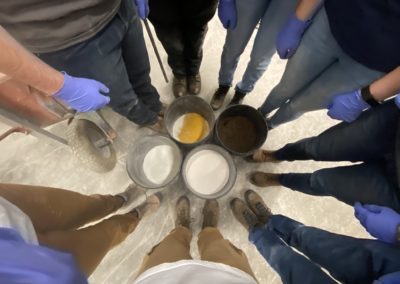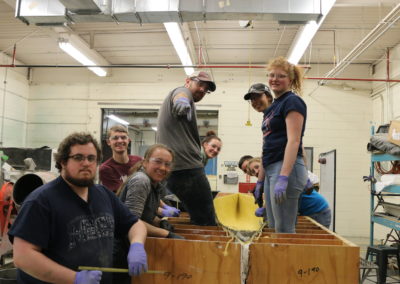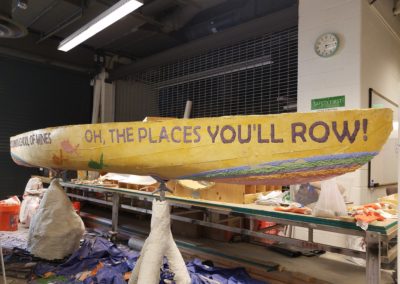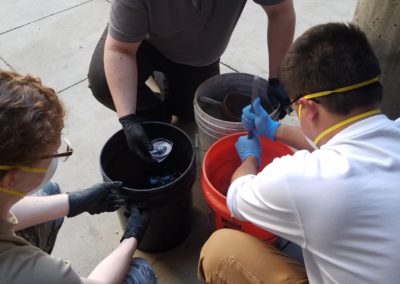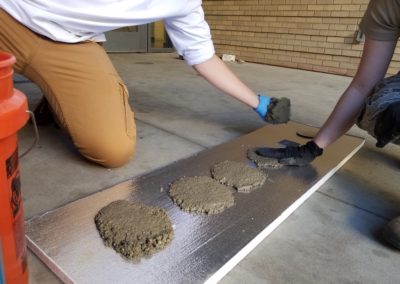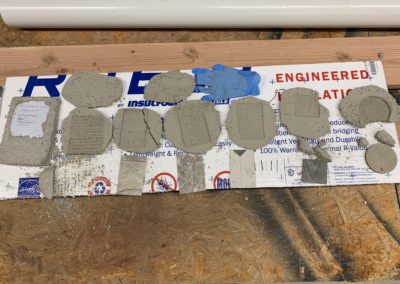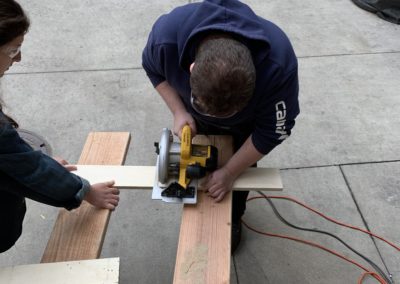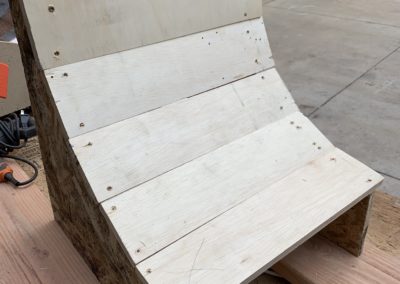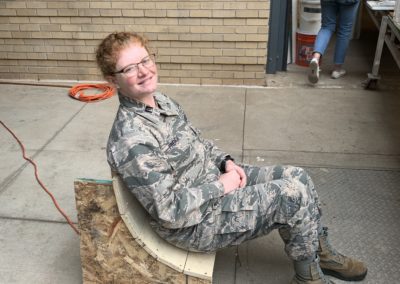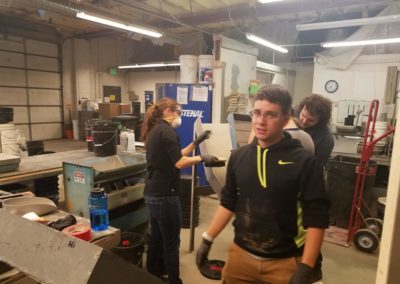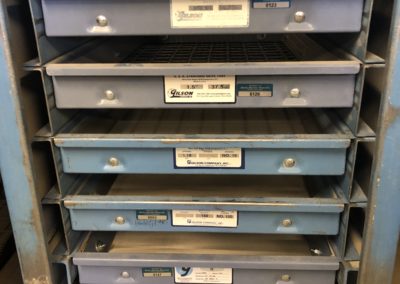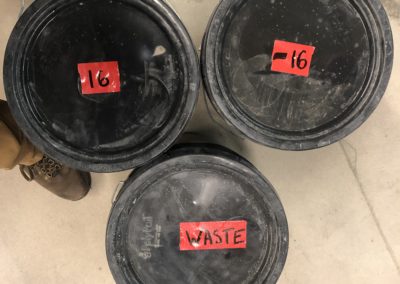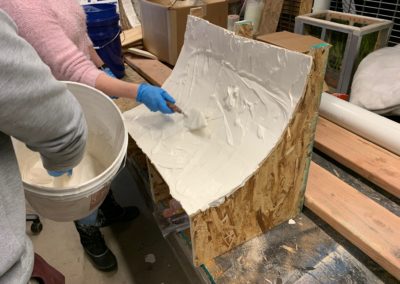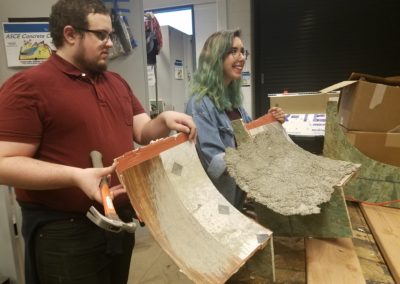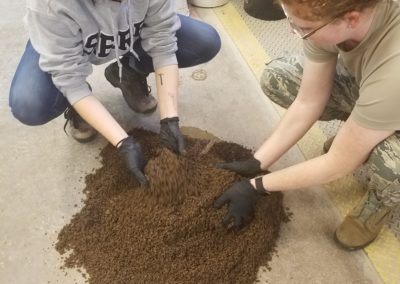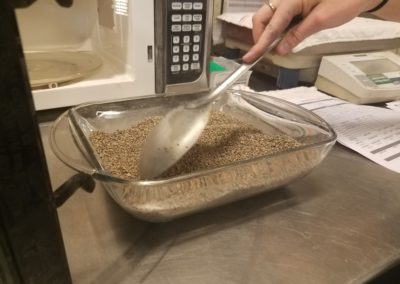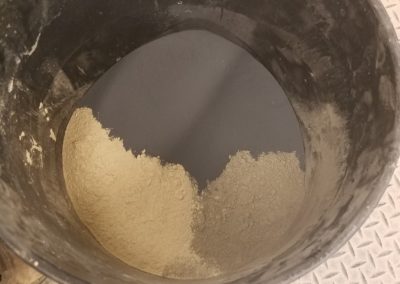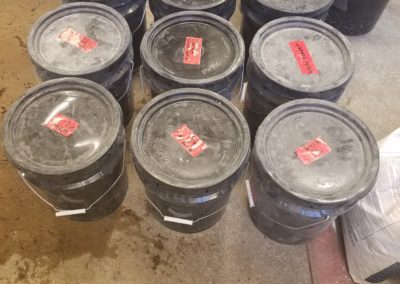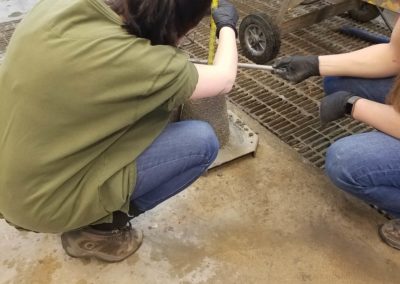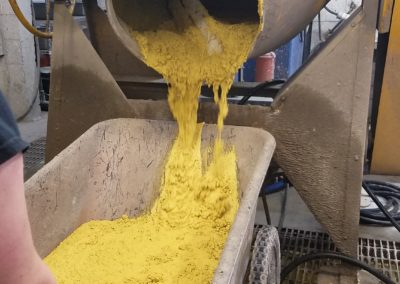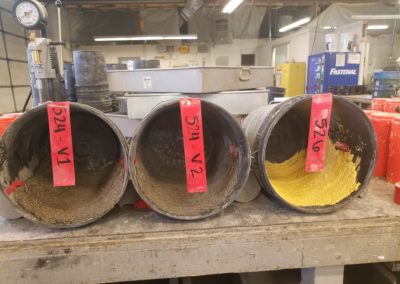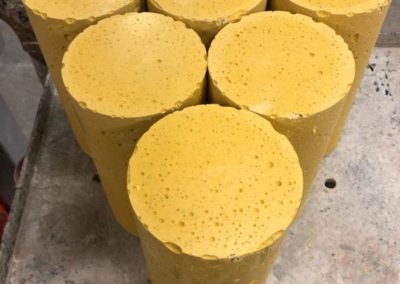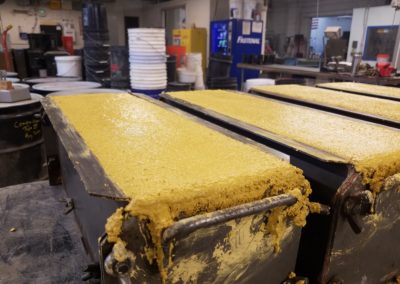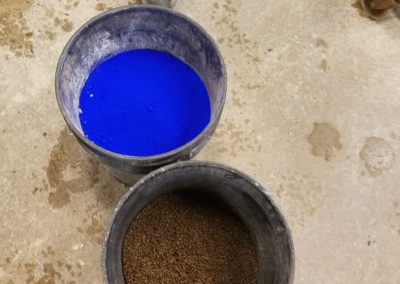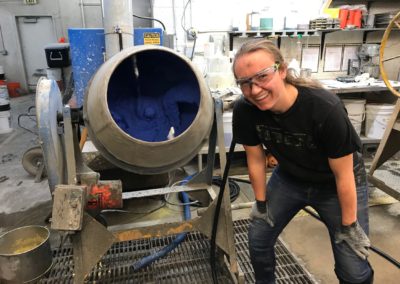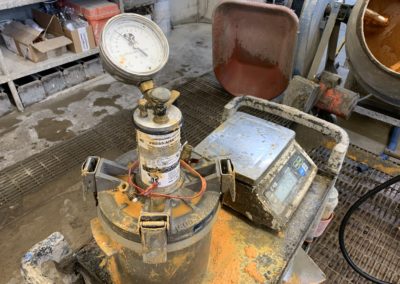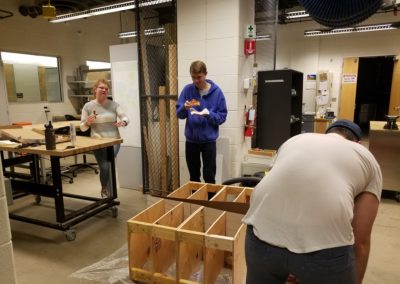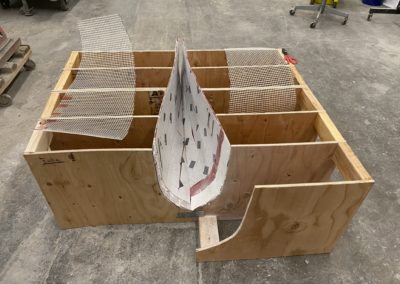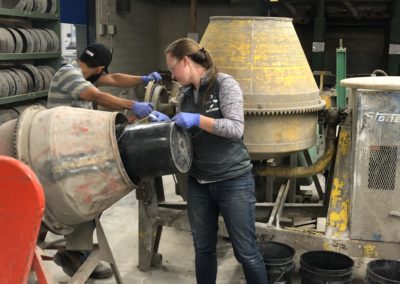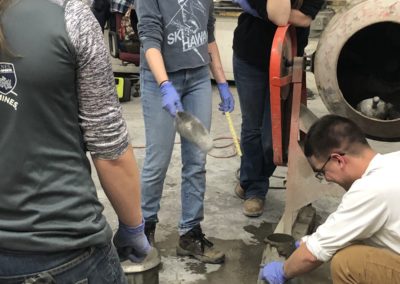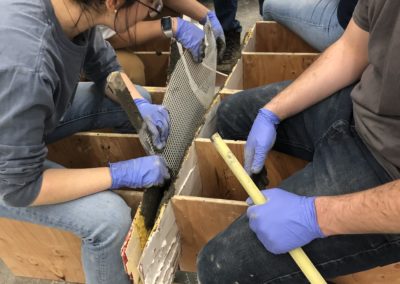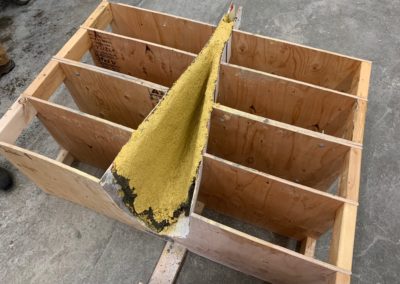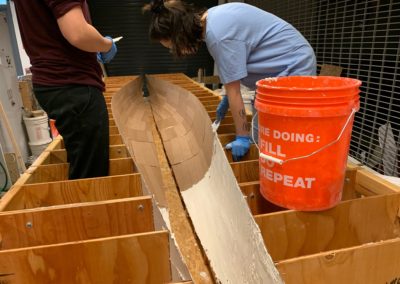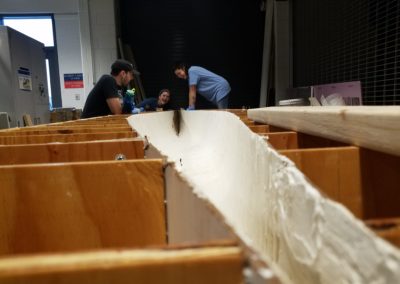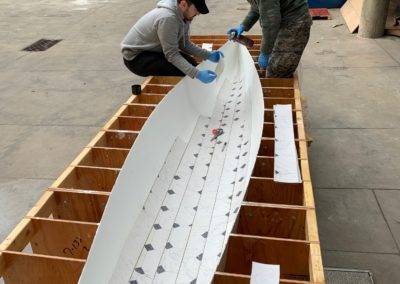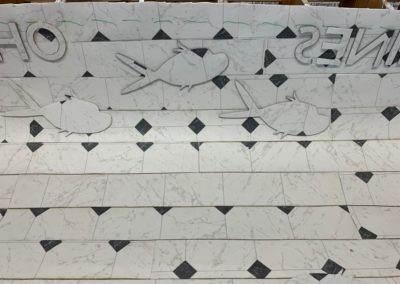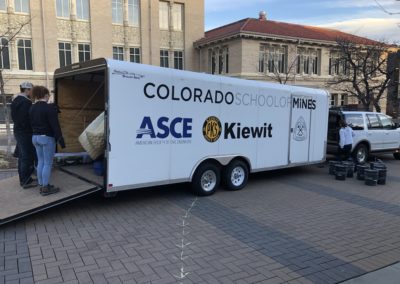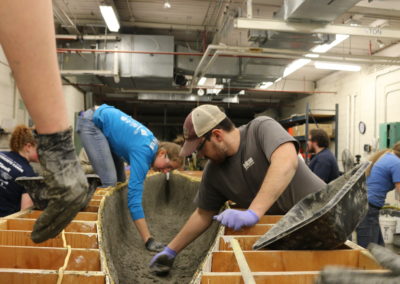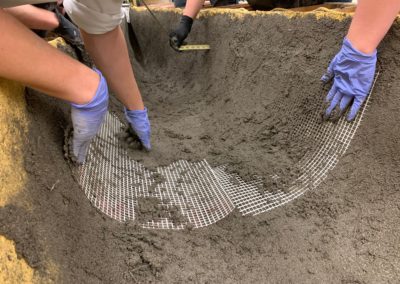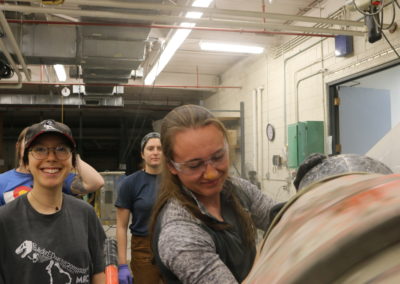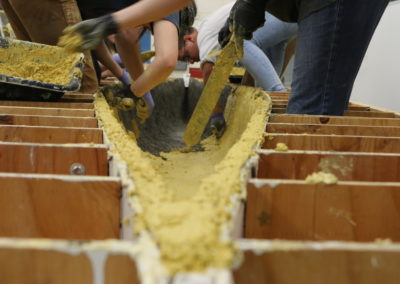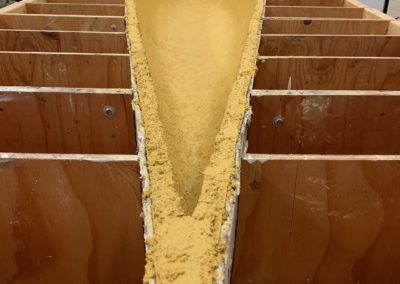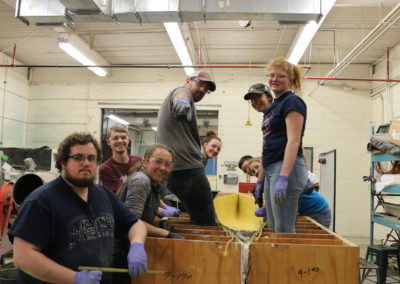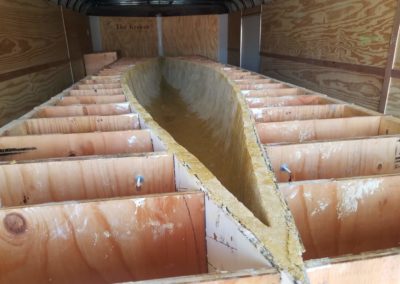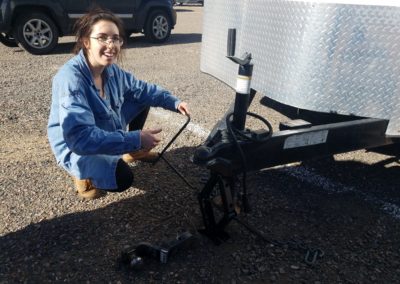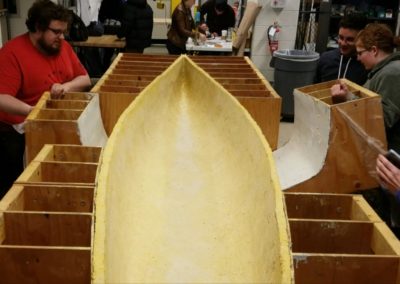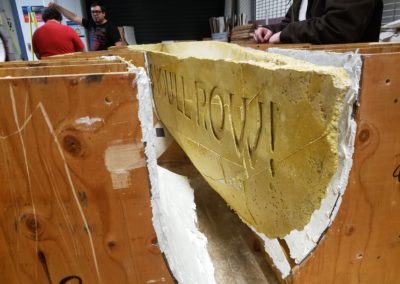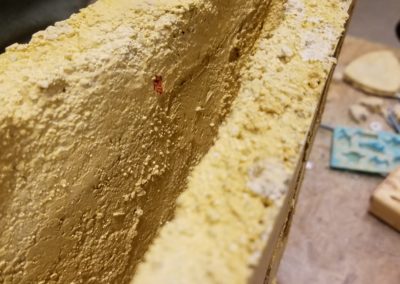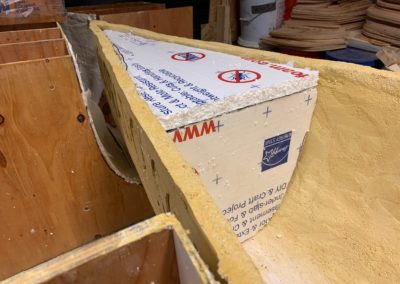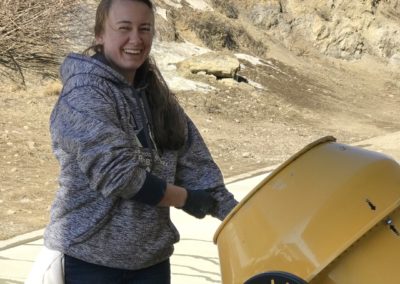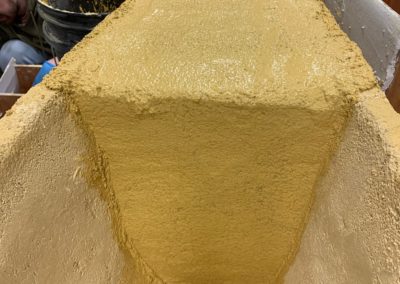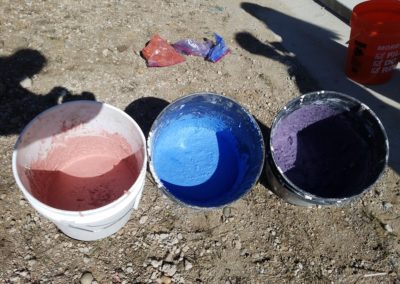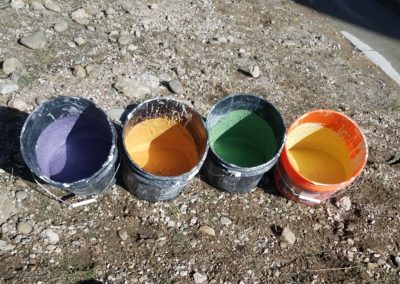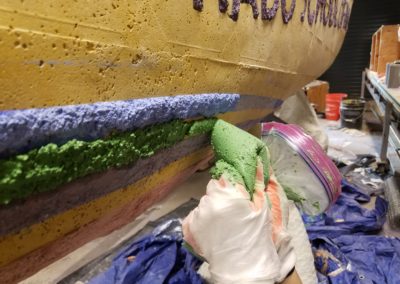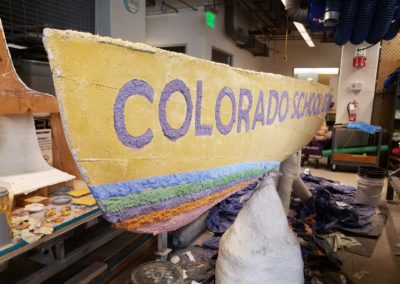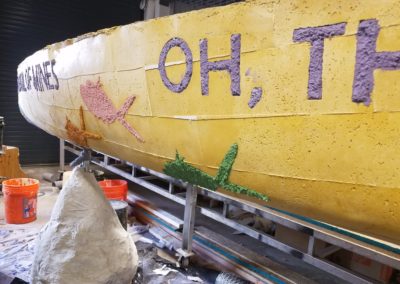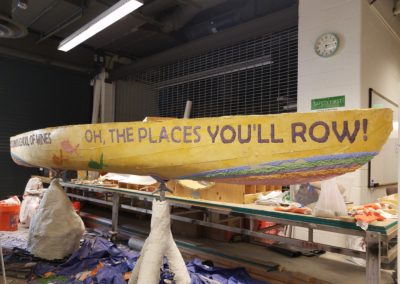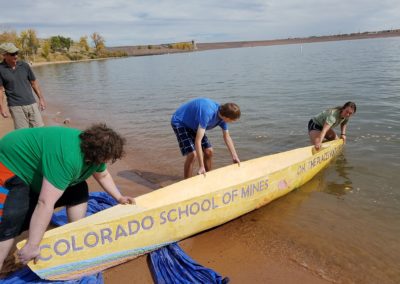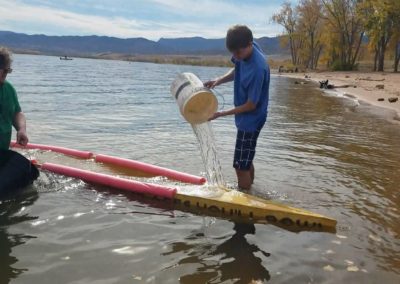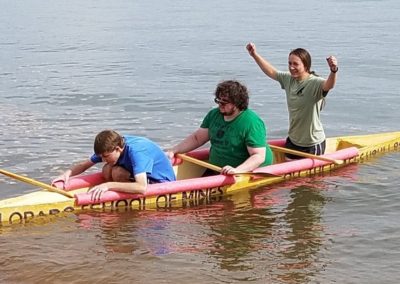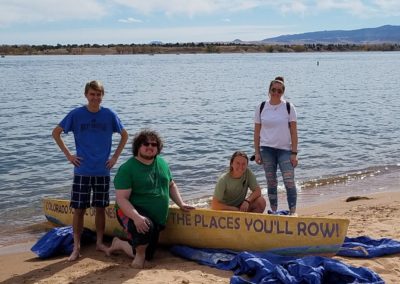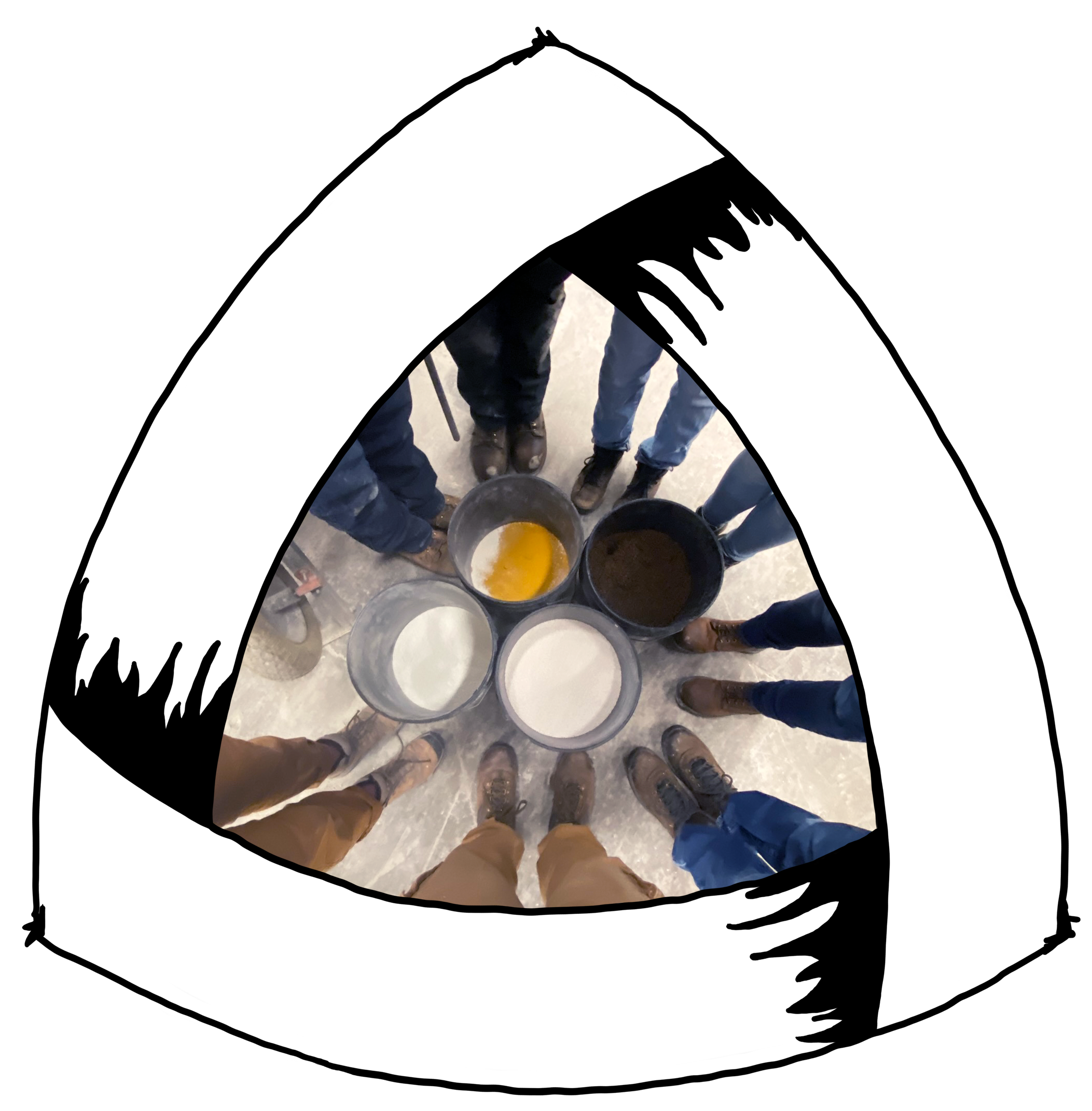Concrete Canoe
Overview
Hello, we are the Colorado School of Mines Concrete Canoe team, two-kay-two-oh! We’d like to tell the story of our canoe, “Oh, the Places You’ll Row!”.
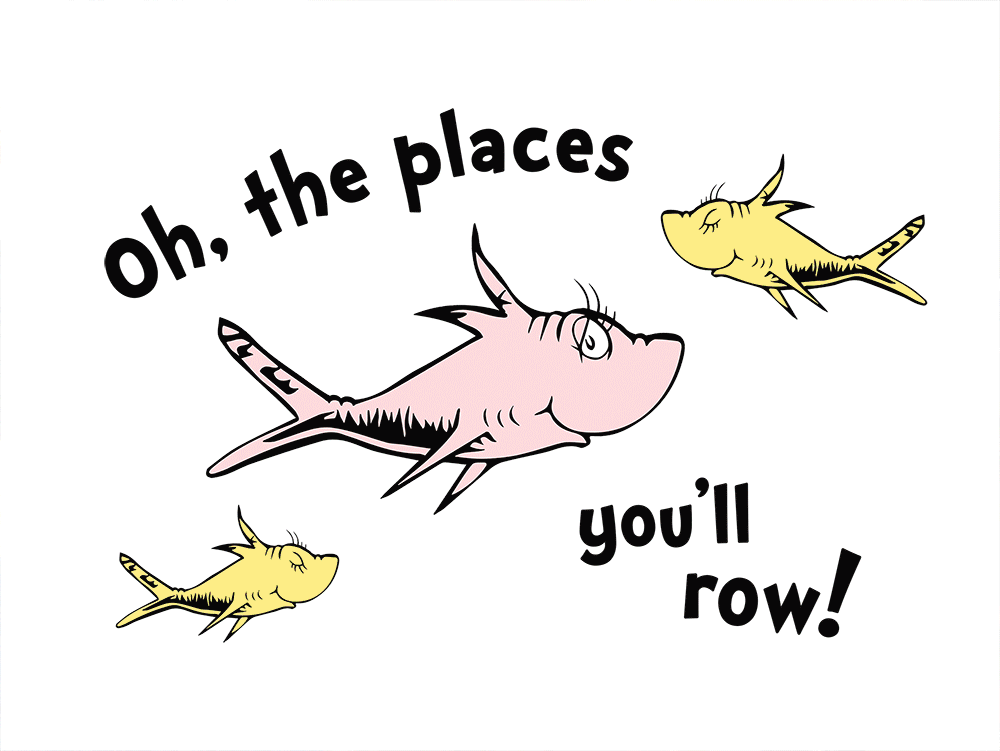
The main objective of this project was to build a full-sized floating canoe entirely out of concrete over the course of around 7 months (2 semesters). This goal was to be achieved through collaboration with professionals in industry.
This project was a submission to participate in ASCE’s 2020 National Concrete Canoe Competition. As part of the usual competition, a technical report is submitted, an oral presentation is given, the canoe is displayed with an accompanying Q&A session, and the canoe is raced against other schools for the fastest time around a given course. Due to current events, however, the final deliverables were whittled down to the technical report, mostly-completed canoe, and video presentation.
ASCE’s stated goals for the competition include the following:
- Providing civil engineering students an opportunity to gain hands-on, practical experience and leadership skills by working with concrete mix designs and project management.
- Building awareness of the versatility and durability of concrete as a construction material among civil engineering students, educators and practitioners, as well as the general public.
- Creating awareness of concrete technology and application among civil engineering students, educators and practitioners, as well as the general concrete industry.
Our team did not have a direct client in the same sense that non-competition teams do. Instead, our client was an industry professional from Kiewit who would provide general guidance, and who we would provide with updates on the project throughout its duration.
Copyright Use
We have been granted permission by Dr. Seuss Enterprises to use the likenesses of the truffula trees and fish in this project.
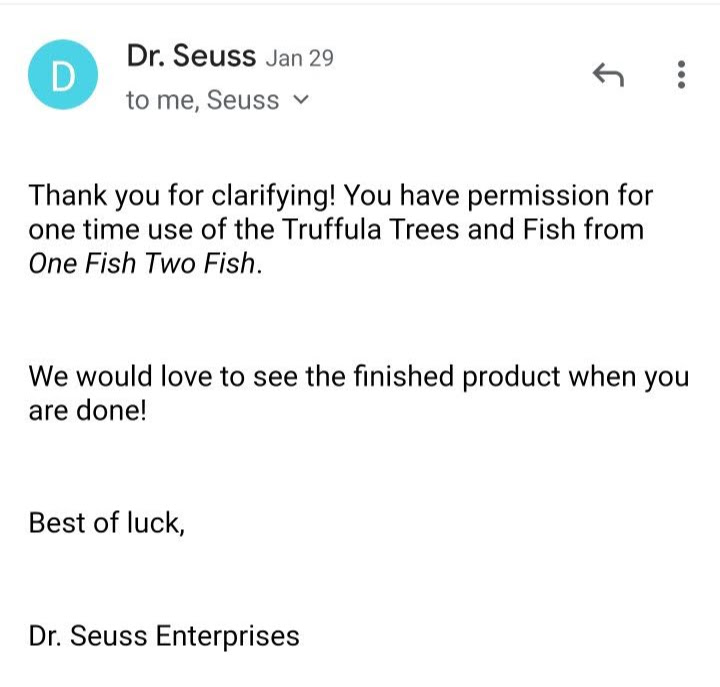
Team Members
- Antoine Broeckx
- Connor Beekman
- Lucy Davis
- Camille Faatz
- Ryan Finnell
- Brittany French
- Matthew Kouba
- Lydia Prather
Acknowledgements
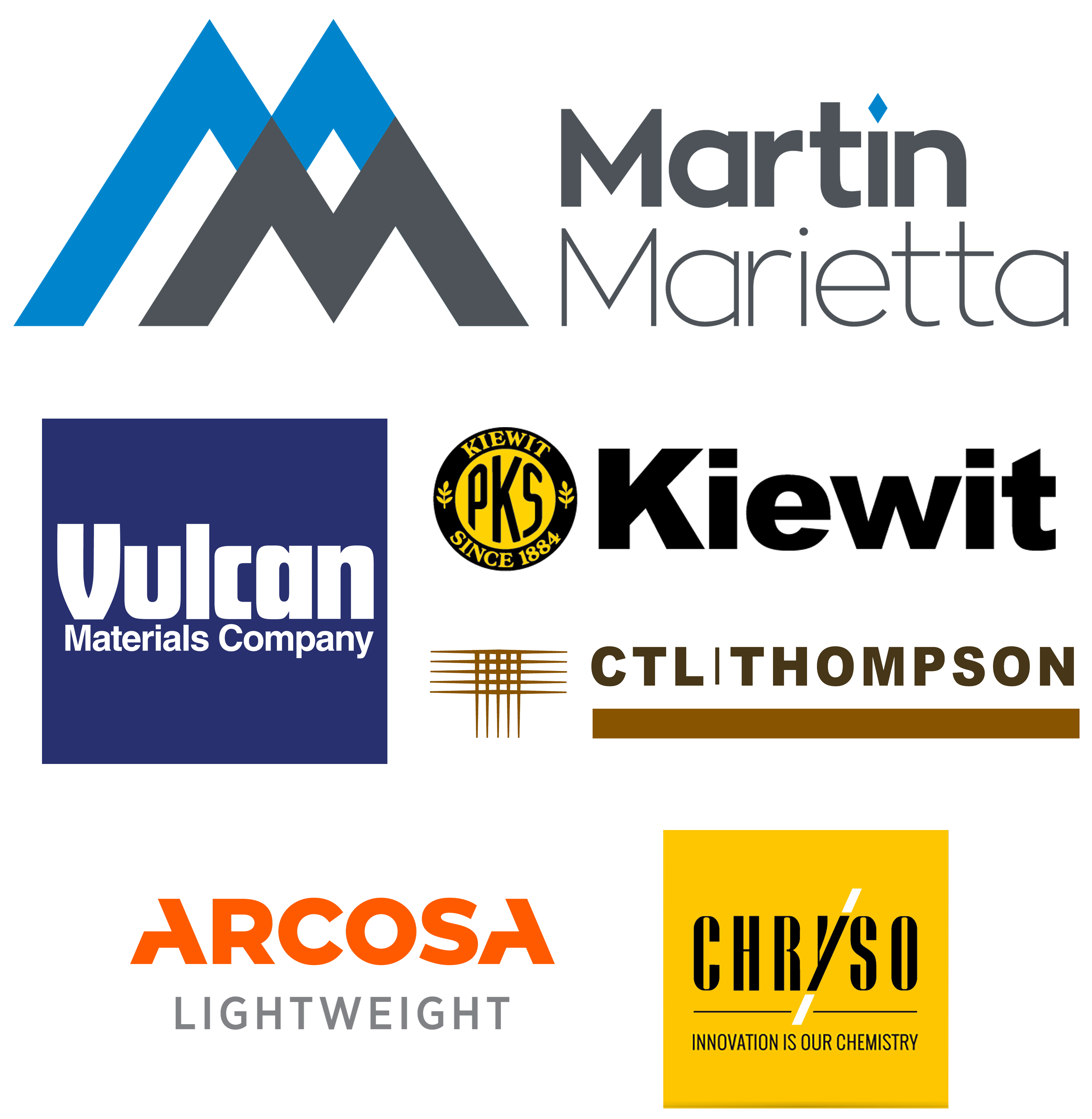
Sponsors: Martin Marietta • Vulcan Materials • Kiewit • CTL Thompson • Arcosa Lightweight • Chryso
We would like to say a big thanks to Prof. David Grimm and Prof. Jeff Holley for being our project advisors. We would also like to thank Martin Marietta for their generous donations of materials, use of their lab space, and their time — and especially to Carly Paige for her expertise and guidance throughout the concrete process. Thanks to Dillon Davisson at Kiewit for his technical advice. Thank you also to the Bureau of Reclamation for letting us use their facilities for Practice Pour Day, Pour Day, and curing. Finally, thank you to everyone who volunteered to donate time/money/resources to make this project possible! A list of all who contributed is located at the end of this post.
MID-PROCESS
Reflection video directed towards next year’s team.
Elevator Pitch / Presentation
Design Approach
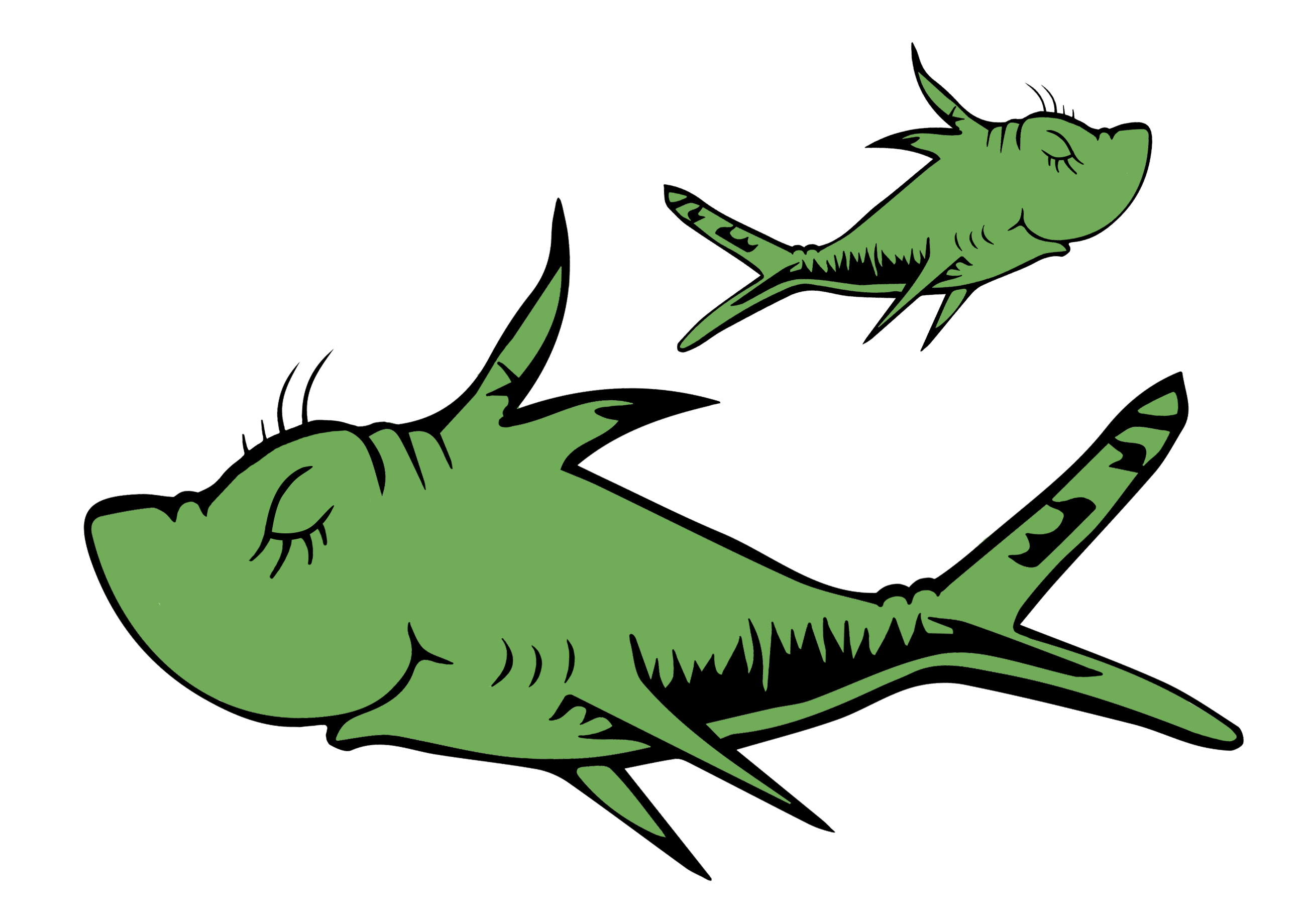 We decided on the theme near the beginning of the project. Starting with a general ‘storybook’ theme, we narrowed it down to ‘Dr. Seuss’ with the help of the tagline/canoe name we all loved, “Oh, the places you’ll row!”. Through outreach to the Dr. Seuss company, we were allowed to use the likenesses of Dr. Seuss’s truffula trees and fish from “Red Fish Blue Fish..”. We used the fish, trees, and a similar overall style in all aspects of our project.
We decided on the theme near the beginning of the project. Starting with a general ‘storybook’ theme, we narrowed it down to ‘Dr. Seuss’ with the help of the tagline/canoe name we all loved, “Oh, the places you’ll row!”. Through outreach to the Dr. Seuss company, we were allowed to use the likenesses of Dr. Seuss’s truffula trees and fish from “Red Fish Blue Fish..”. We used the fish, trees, and a similar overall style in all aspects of our project.
Through our decision on the theme, we curated a pigment palette for the concrete: pink, orange, yellow, green, blue, and purple. We chose yellow to be the main color of the canoe, with words and additional designs displaying the other colors. Inlays for the canoe mold were designed to include fish, our canoe name, and school name. Ex-lays in the form of decorative stripes were also designed. We planned for the stand to represent 3 truffula trees crossing in front of a mountain, but were not able to finish before our lab was closed. Other final aesthetic items we had to leave unfinished include a cutaway of the mold and canoe, and a display case to show the array of materials that were used in the concrete mixes.
For the hull of the canoe, we took last year’s canoe length and geometry into account while making our own adjustments. We wanted to balance maneuverability and speed, and through research decided on a canoe length of 16 feet. We gathered information to learn how different geometries would affect the canoe’s performance in racing conditions and applied the knowledge to our final design to meet our primary focuses. Some of these geometry considerations and their effects include:
- V-shaped keel: improved primary and secondary stability
- Short length: more maneuverability, less material used
- Asymmetrical design (centroid is not central): increased forward speed
- (Small) rocker: better tracking, simplified construction
- Sharp entry line: increased speed
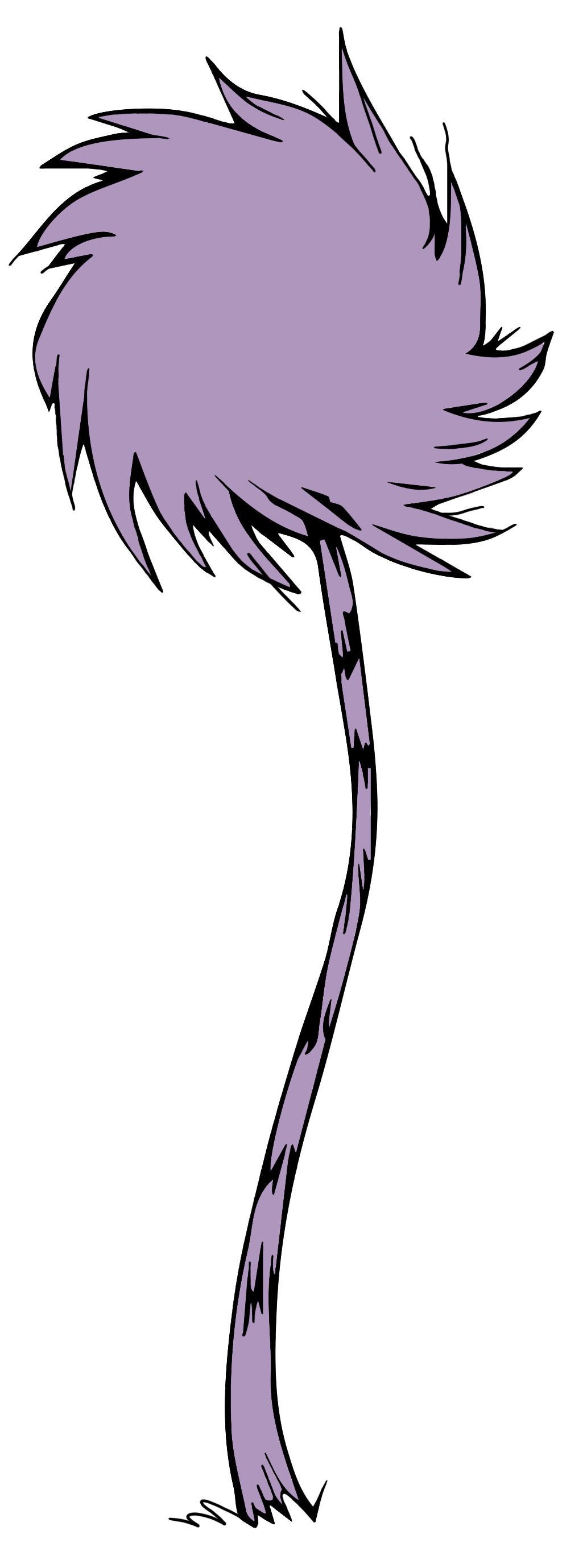 We decided to take a completely different approach to our canoe mold this year, which meant that we could not take as much guidance from previous years’ solutions. We wanted our form to be reusable as well as recyclable, so we did not want to use polystyrene foam. To make the form itself reusable, our team came up with a modular design that allowed small sections to be de-molded individually and screwed back together if needed. We also considered spacing between sections to give team members access to the form while placing concrete. We CNC’d the canoe’s shape into each section according to our SolidWorks design. We then connected the cutouts of each section with hardboard, which was able to bend to the canoe’s curvature.
We decided to take a completely different approach to our canoe mold this year, which meant that we could not take as much guidance from previous years’ solutions. We wanted our form to be reusable as well as recyclable, so we did not want to use polystyrene foam. To make the form itself reusable, our team came up with a modular design that allowed small sections to be de-molded individually and screwed back together if needed. We also considered spacing between sections to give team members access to the form while placing concrete. We CNC’d the canoe’s shape into each section according to our SolidWorks design. We then connected the cutouts of each section with hardboard, which was able to bend to the canoe’s curvature.
We tested wood as a primary material by successfully building a singular section of the proposed mold. From there, the team prototyped and tested the design of the overall mold until the final canoe design was completed. One issue we had to consider was that once the canoe was poured, it would sit in the form in a 100% humidity room for 1 week to cure. To prevent the wood of the form from warping, we decided to cover it in polyurethane, which proved to be successful in a test where a prototype was stored in a 100% humidity room for 7 days. We covered the hardboard on the inside of the form in a layer of plaster followed by vinyl to ensure easy demolding from the concrete. Our team decided on these materials early in the design process by testing the demolding of Quikrete on an array of different substances.
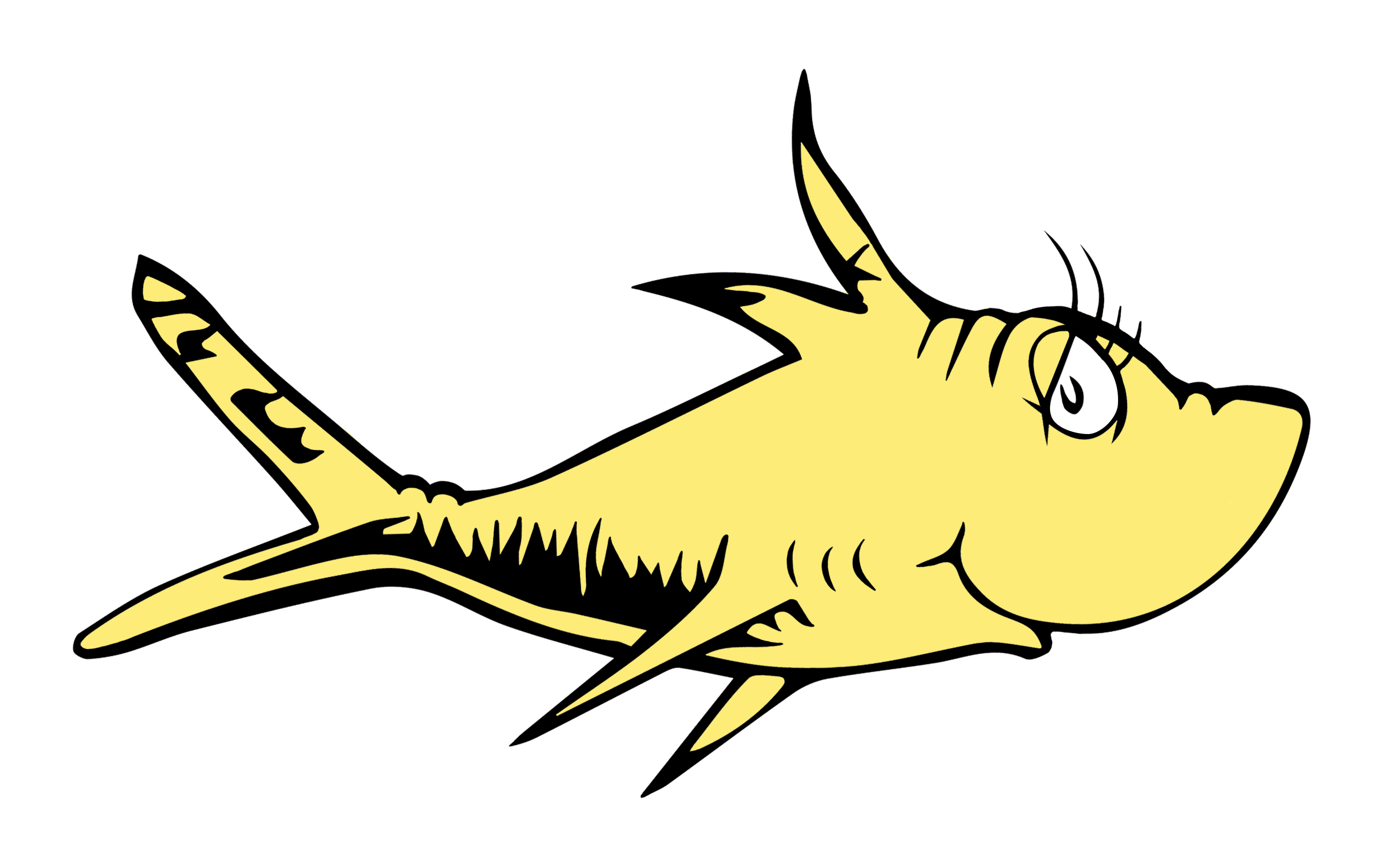 Our concrete mixes were based somehwat on last year’s designs but adjusted to fit our own specifications. Two lightweight concrete mixes were designed and proportioned to fit the structural and aesthetic needs of the canoe. ASCE limited the proportions and contents of the mixes for the competition.
Our concrete mixes were based somehwat on last year’s designs but adjusted to fit our own specifications. Two lightweight concrete mixes were designed and proportioned to fit the structural and aesthetic needs of the canoe. ASCE limited the proportions and contents of the mixes for the competition.
First, we separated the aggregate into #16 and –#16 using a screen shaker to utilize all sizes of our lightweight aggregate across both mixes. The structural mix was designed to have the lowest unit weight, as it would make up the most volume of the canoe. Our team continued the tradition of using a plastic mesh as reinforcement in the middle of the structural layer to increase the tensile strength and therefore the maximum bending moment of the canoe. The aesthetic mix, used just to coat the structural layer, was designed with a white cement base so that it could be pigmented to display our chosen color scheme. We ran and tested our mixes at Martin Marietta multiple times to hone the workability, strength, and unit weights of each concrete mix as well as to practice batching, mixing, and admixture dosing.
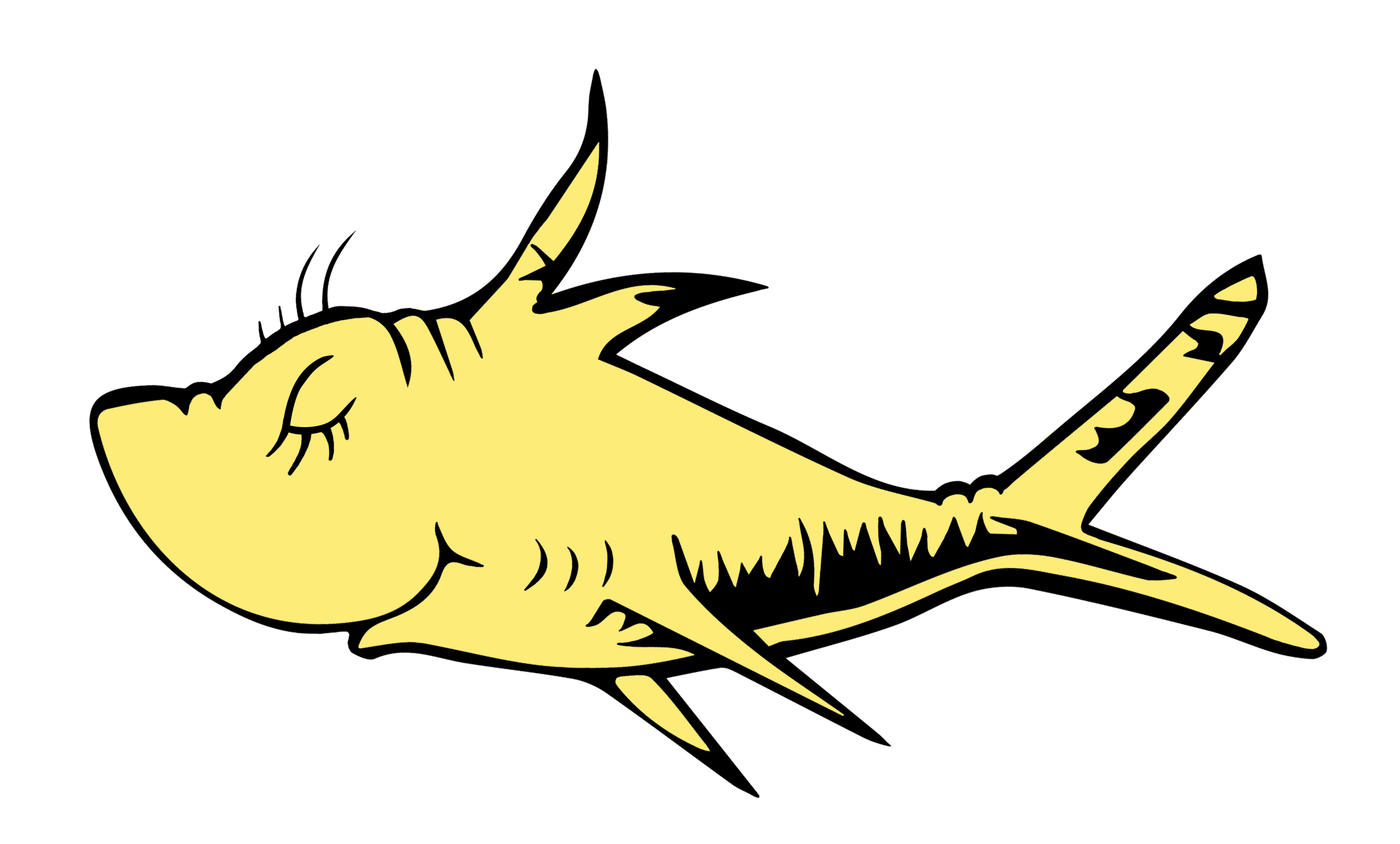
Last year’s canoe was slightly unstable because it was very buoyant. To fix this issue, we wanted concrete mixes with higher unit weights, so we decreased the proportion of smaller particles. However, we did not consider these increased unit weights in conjunction with increased thicknesses; instead of spraying on the concrete like last year, our team wanted to hand-place the concrete due to concerns with constructability regarding the use of the spraying mechanism. Our choice to hand-place the concrete resulted in layers that were thicker than intended. The thicker layers resulted in a much higher canoe weight than anticipated, which we counteracted by adjusting the bulkhead size accordingly.
We mainly used hand calculations to carry out structural analysis on the canoe. We created shear and moment diagrams to illustrate loading cases for the race scenarios (2 paddlers, 4 paddlers) to find the maximum shear force and the bending moment of each. For the sake of the calculations, we estimated that the uniform distributed weight of the canoe was 31.25 lb/ft and that each rower was 200lb.
After we weighed the canoe (4 team members stood on scales, recording their change in weight when all holding the canoe together), we performed buoyancy calculations to determine the needed volume of the bulkheads. We found that about 2.6 cubic feet total of polystyrene foam was needed to bring the total unit weight of the canoe to 60 pcf, which is less than water (64 pcf). The foam was divided between the two ends of the canoe to be bulkheads, shaped to fit, then covered in a thin layer of yellow aesthetic concrete to bind it to the canoe.
Pour Day
After 5 months of planning the hull design, creating the form, and finalizing the concrete mixes, we were finally ready to make our canoe come to life! On a Saturday over the span of ~12-hours, we were joined by volunteers at the Bureau of Reclamation to mix and lay the concrete in our mold, which ended up requiring around 7.5 CF total. When the canoe was finished, we rolled it into the 100% humidity room to cure for 7 days (not 28 days, only due to storage limitations).
Design Solution
Mold
Construction Drawings
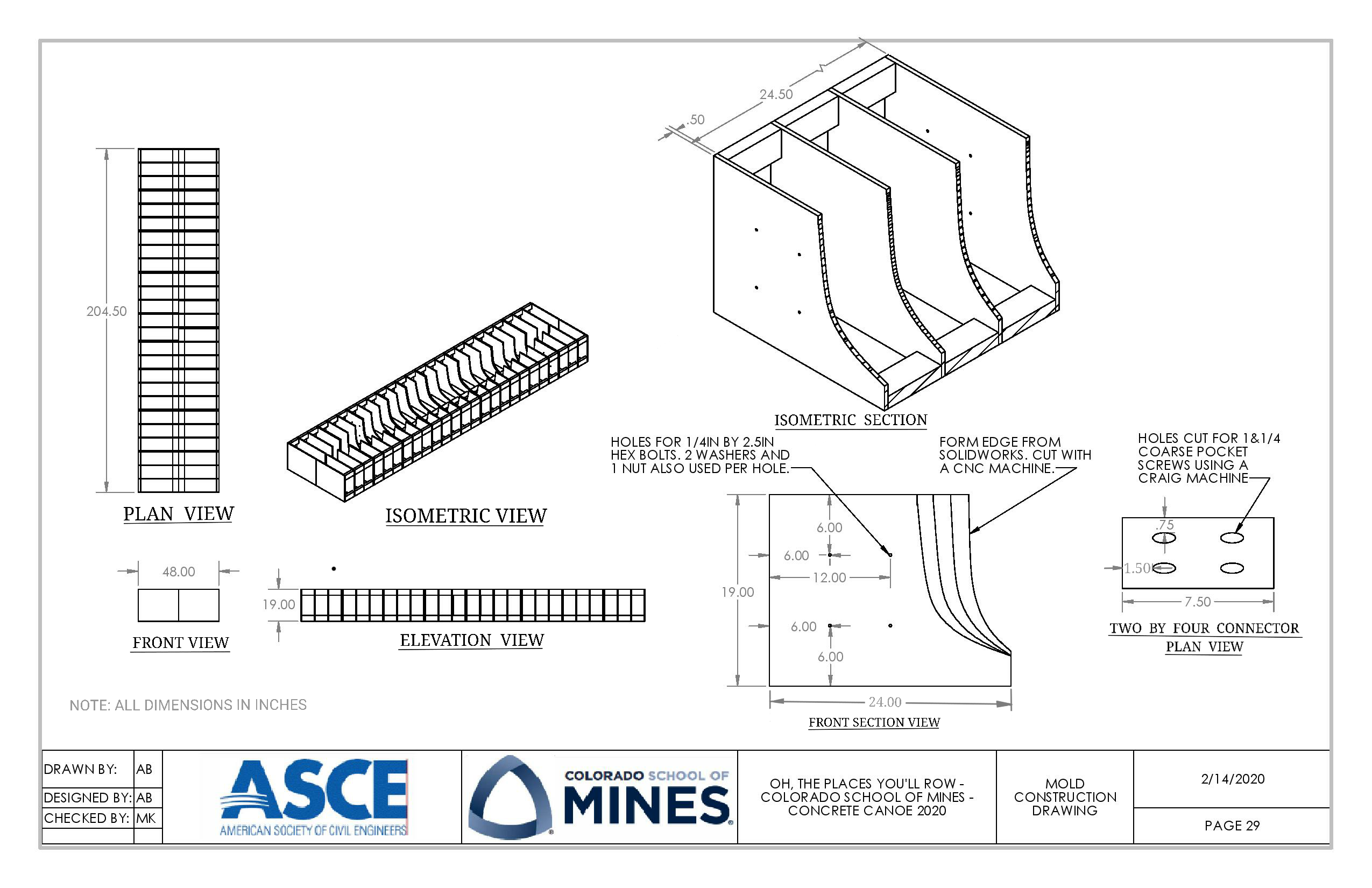
Building the Form
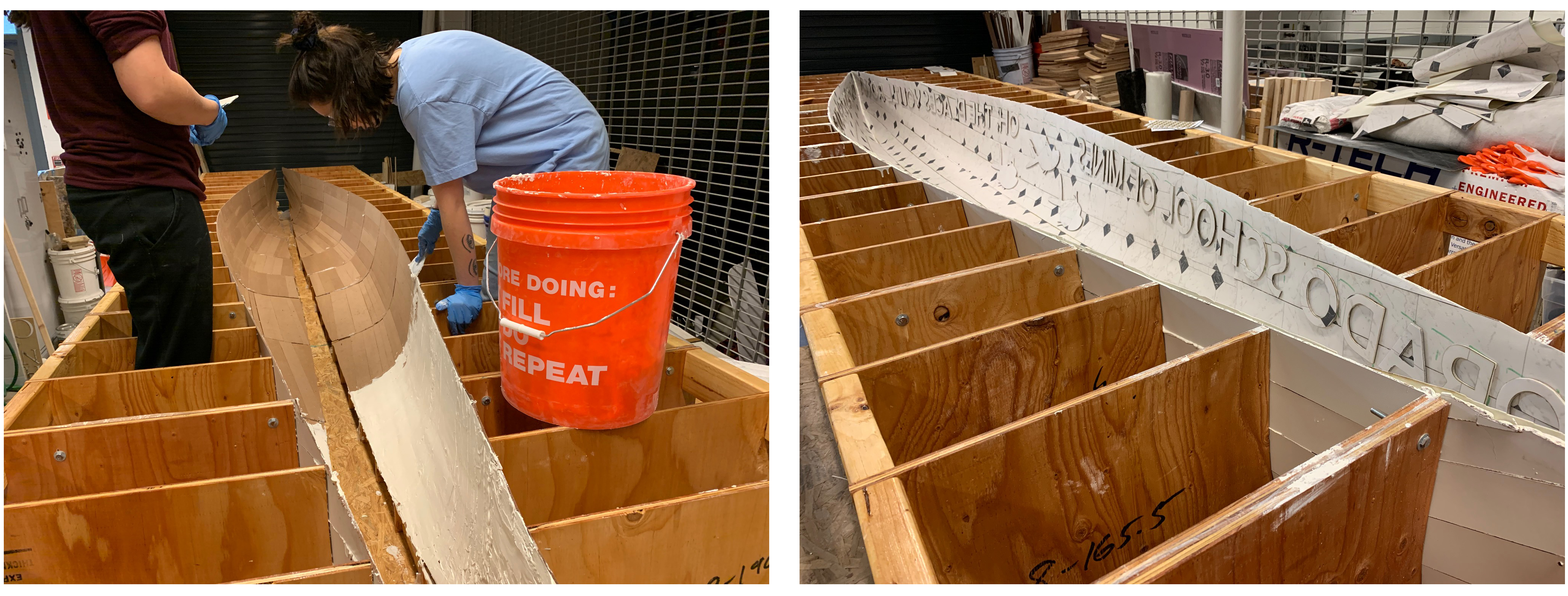 After we designed the form in SolidWorks, we CNC’d boards for each section using the geometry of the canoe cross-section at designated points. We connected the sections with hardboard, which bent to shape. Then we plastered the hardboard and covered it in vinyl to demold from the concrete. After we poured our canoe, our form worked as intended, demolding piece-by-piece and holding its shape in 100% humidity. The vinyl base and inlays detached from the concrete very easily and left a smooth impression on the concrete, besides the seams in between strips. (Shown below: removing modular sections to demold)
After we designed the form in SolidWorks, we CNC’d boards for each section using the geometry of the canoe cross-section at designated points. We connected the sections with hardboard, which bent to shape. Then we plastered the hardboard and covered it in vinyl to demold from the concrete. After we poured our canoe, our form worked as intended, demolding piece-by-piece and holding its shape in 100% humidity. The vinyl base and inlays detached from the concrete very easily and left a smooth impression on the concrete, besides the seams in between strips. (Shown below: removing modular sections to demold)
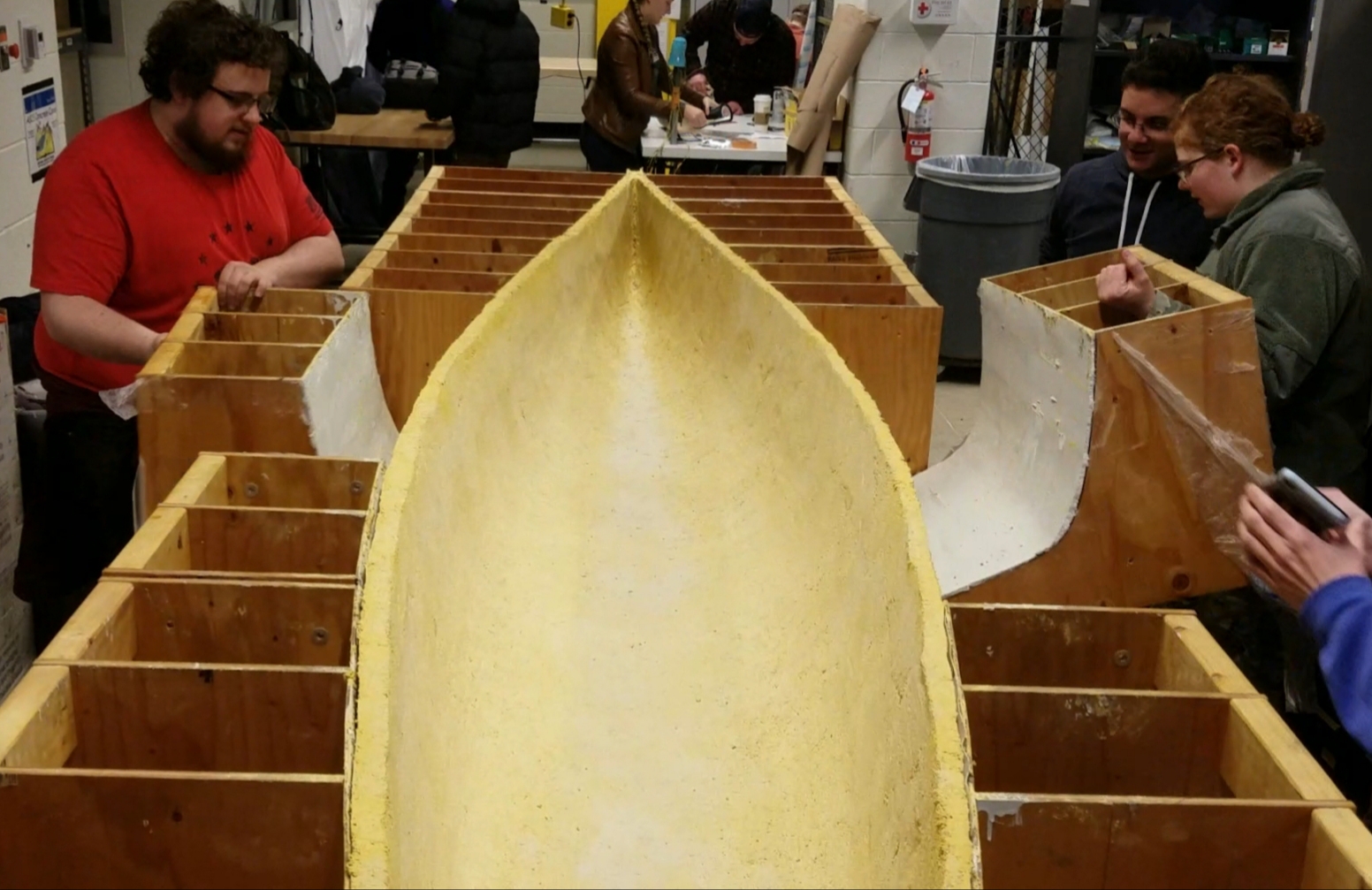
Hull
DELFTShip Design
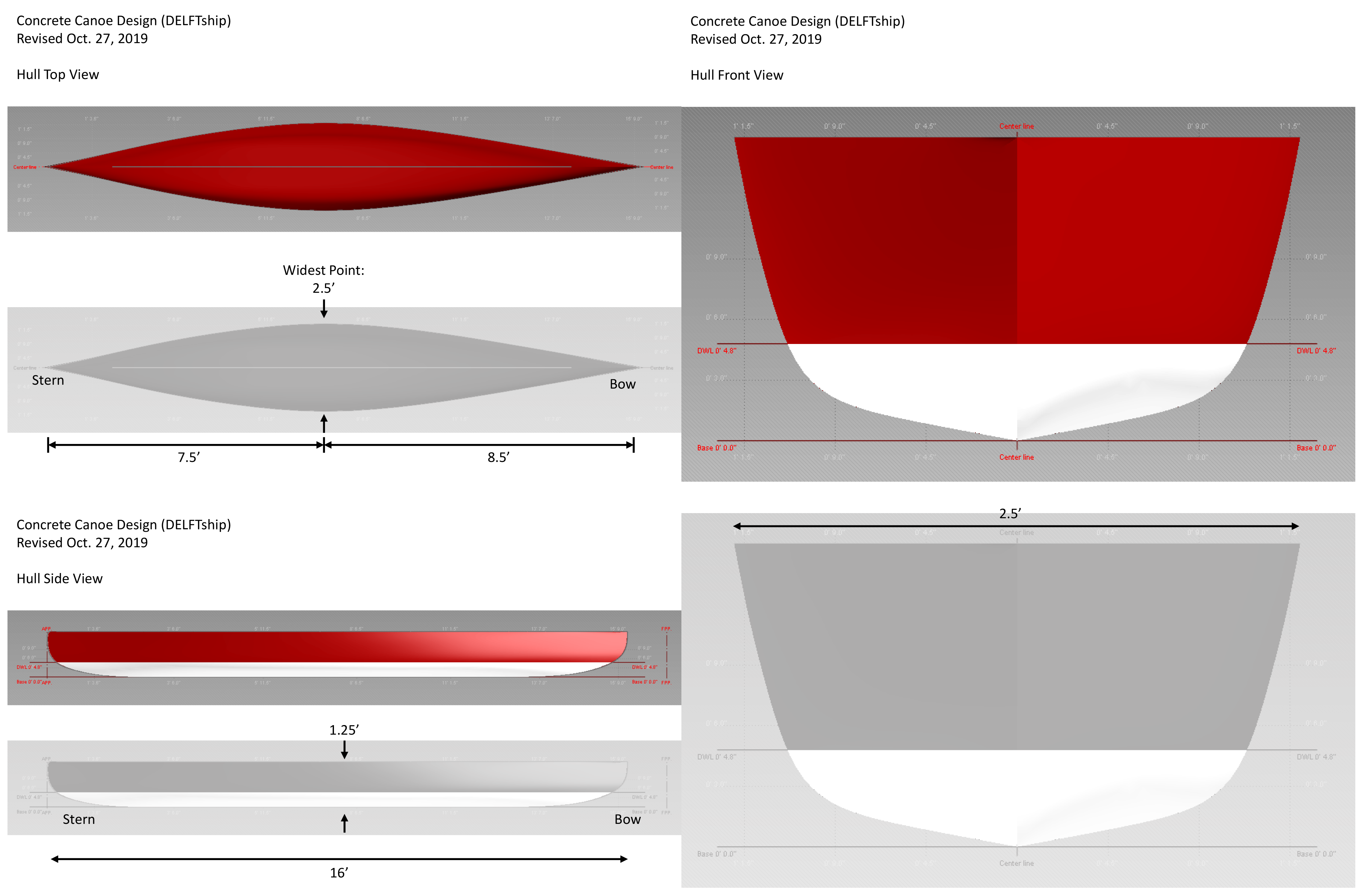
Loading Cases
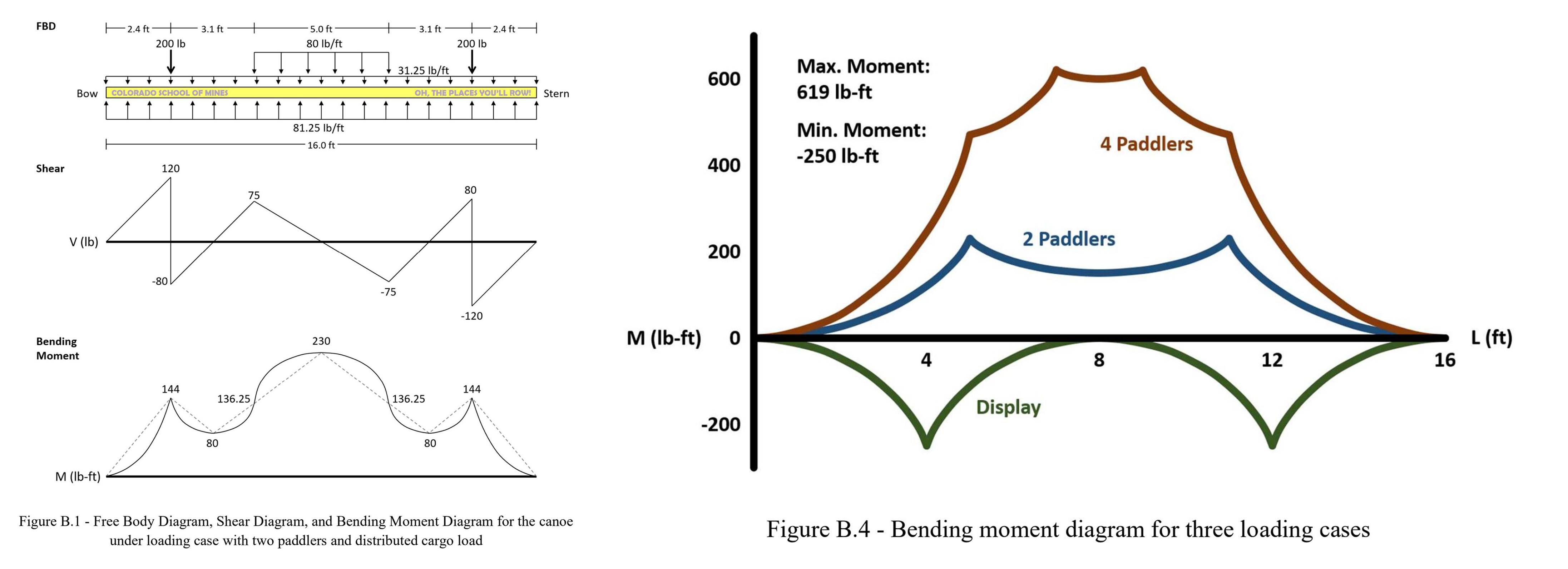
Poured Hull (just after curing, demolding)
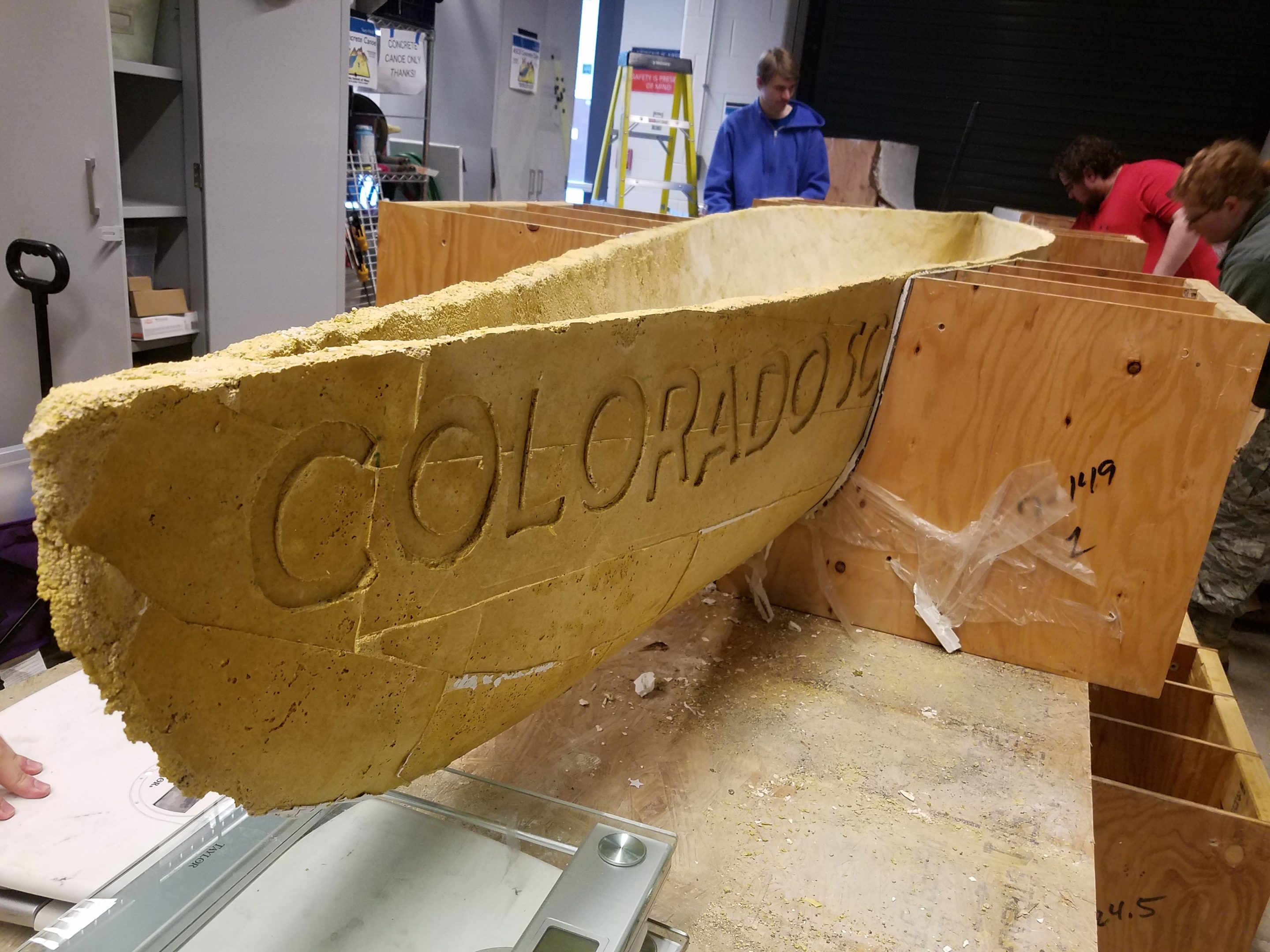
The hull turned out mostly as planned, though our centerline ridge ended up less defined than intended due to constructability issues. We planned to sand the canoe to perfect the edges as well as to smooth the outside for a more hydrodynamic surface, but we were ultimately unable to due to lab closure. The canoe is thicker than designed and thus heavier, but the shape is accurate and we are confident that our boat would have been a contender in the races. The final composition consisted of 2 layers of aesthetic each at 1/4″ with a structural layer of 1/2″ in between them. With the reinforcement mesh at 1/16″, the total thickness was 1-1/16″.
Mixes
Mix Designs
Two concrete mixes were developed for the canoe: a structural mix targeting a low unit weight and an aesthetic mix with the main purpose of pigment-ability for color display. Both mixes included set retarding admixture to allow more time for placement when pouring the full canoe.

The structural mix was designed to have a low unit weight, mainly by using small particles and adding a large dose of air-entraining agent (AEA). The aggregate we used in the mix included -#16 aggregate and expanded glass beads, which are a recycled glass material with a very porous structure. Supplementary cementitious materials (SCMs) we used included C-ash and silica fume, which together increased strength, increased workability (and therefore allowed lower w/cm ratio), and lessened problems with cracking. We also used fibers to decrease cracking, decrease shrinkage, and increase overall durability. The main changes we made to the mix over time included decreasing the AEA, trading lower unit weight for higher strength, as well as increasing the water content to improve workability and eliminate dough balls.
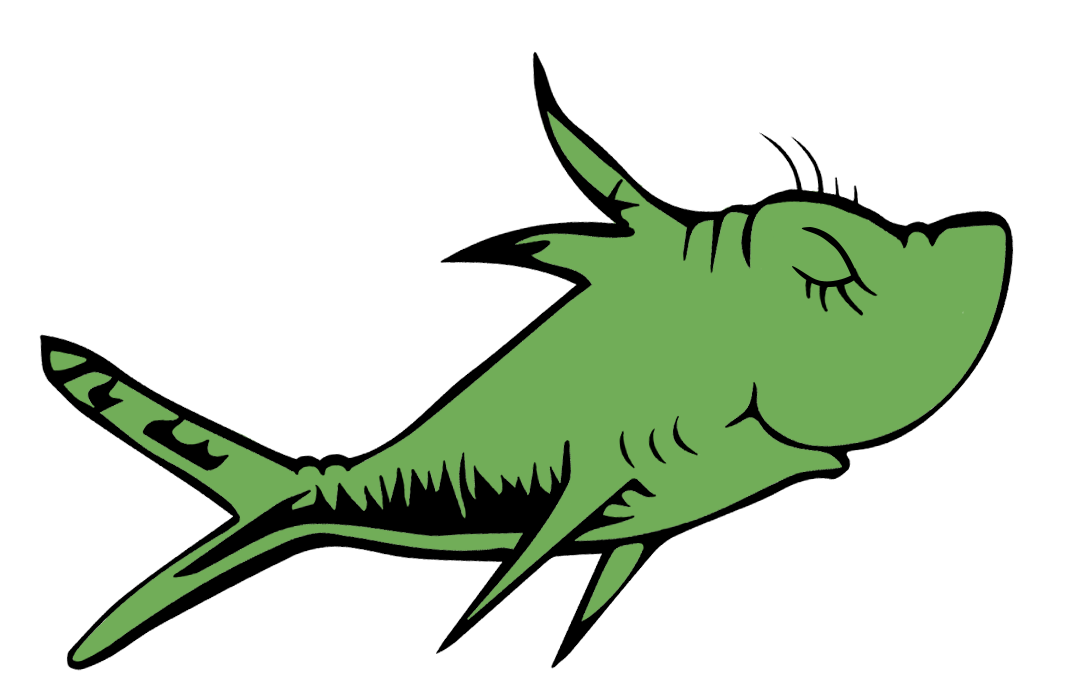 To ensure a pure base for pigmentation, the aesthetic mix was designed with white cement and without SCMs. We decided not to use fibers in an effort to keep a smooth outside texture. Because we planned for the aesthetic concrete to make up a much smaller portion of the canoe than the structural mix, a low unit weight was not as much of a priority. Therefore, we did not add AEA and we used a higher cement content, which increased the strength to almost double that of the structural mix. We used #16 aggregate for this mix, effectively using all sizes of the lightweight aggregate order for sustainability. Below are the mix sheets for each design.
To ensure a pure base for pigmentation, the aesthetic mix was designed with white cement and without SCMs. We decided not to use fibers in an effort to keep a smooth outside texture. Because we planned for the aesthetic concrete to make up a much smaller portion of the canoe than the structural mix, a low unit weight was not as much of a priority. Therefore, we did not add AEA and we used a higher cement content, which increased the strength to almost double that of the structural mix. We used #16 aggregate for this mix, effectively using all sizes of the lightweight aggregate order for sustainability. Below are the mix sheets for each design.
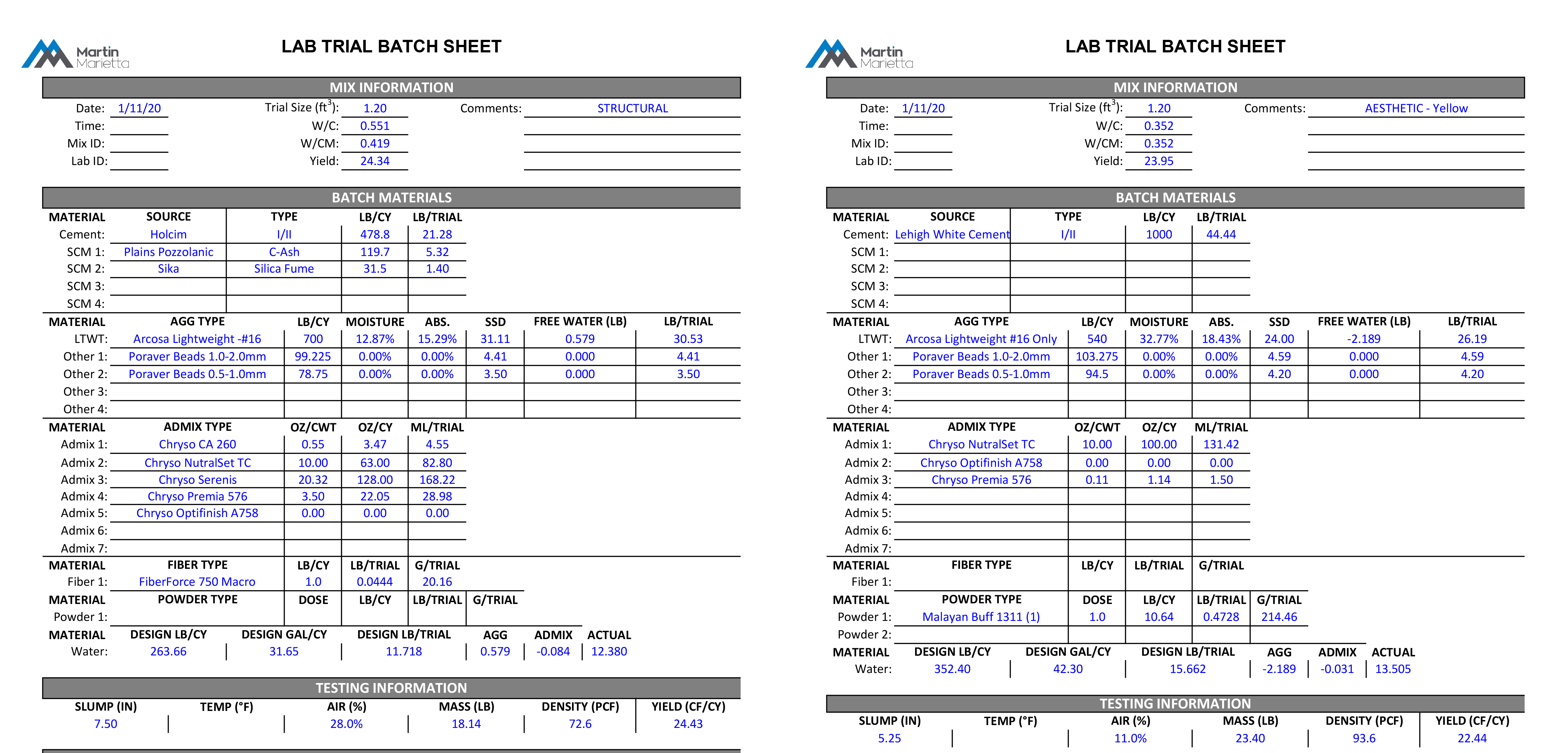
Like previous teams, we experienced differences in trial size and yield during testing, with calculated yield being around 15% less than intended. To fix the issue, trial sizes were increased to 120% to align with the needed yield and include a factor of safety of 5%. However, after mixes had been established, a past test led us to believe that the glass beads may truly have no absorption (contrary to the information provided on their data sheet). With this assumption, yield calculations finally matched the intended trial size, providing a possible explanation and solution to the problem. Because mixes had been finalized, the only change we could make was to update the mix sheets to reflect our assumptions.
Results
Tests performed at Martin Marietta for each of the two mixes include fresh [slump, unit weight, air] and hardened [split-tensile strength, compressive strength, flexural strength, oven-dry unit weight]. Strength test results are displayed in the table below (* = estimation, interpolated from collected data). Further below, cylinders representing all final colors of aesthetic concrete are shown next to a grey structural specimen.
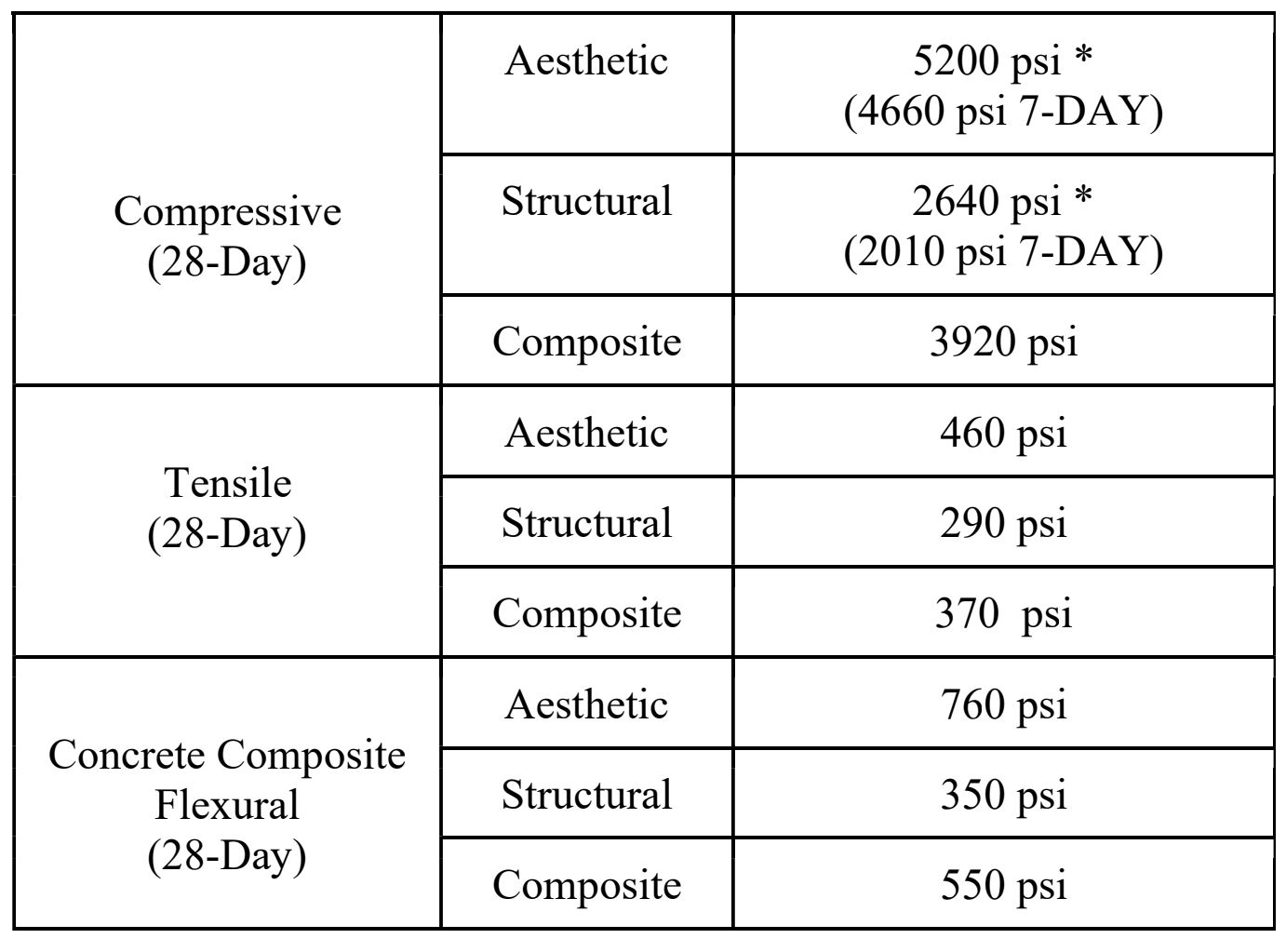
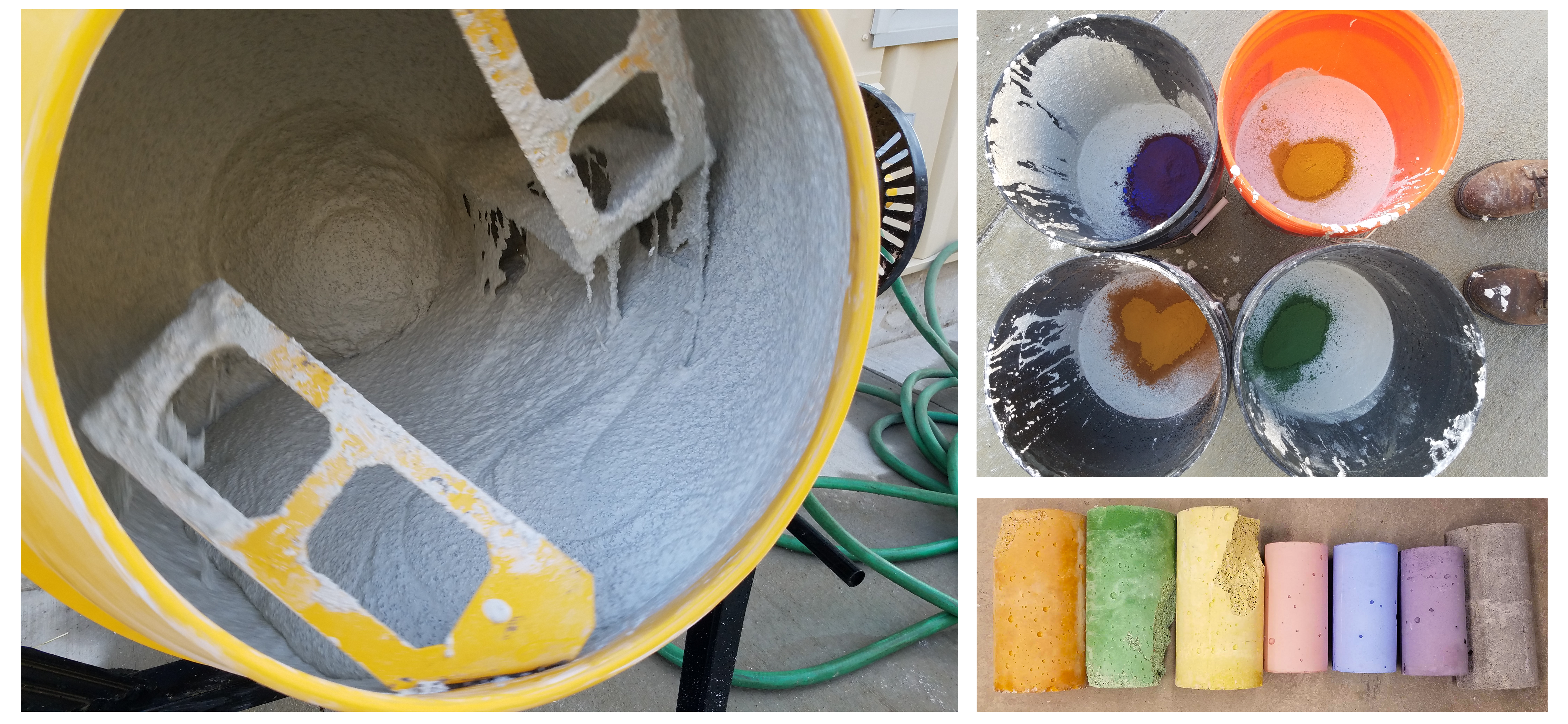
Costs
Materials Costs
We were fortunate enough and extremely grateful to have materials, funds, and hundreds of volunteer hours donated to us throughout the project. Below are the cost estimates of materials for each portion of the project, as well as an estimate of labor costs if all positions were being paid at a theoretical hourly wage.
 Work Distribution and Labor Costs
Work Distribution and Labor Costs
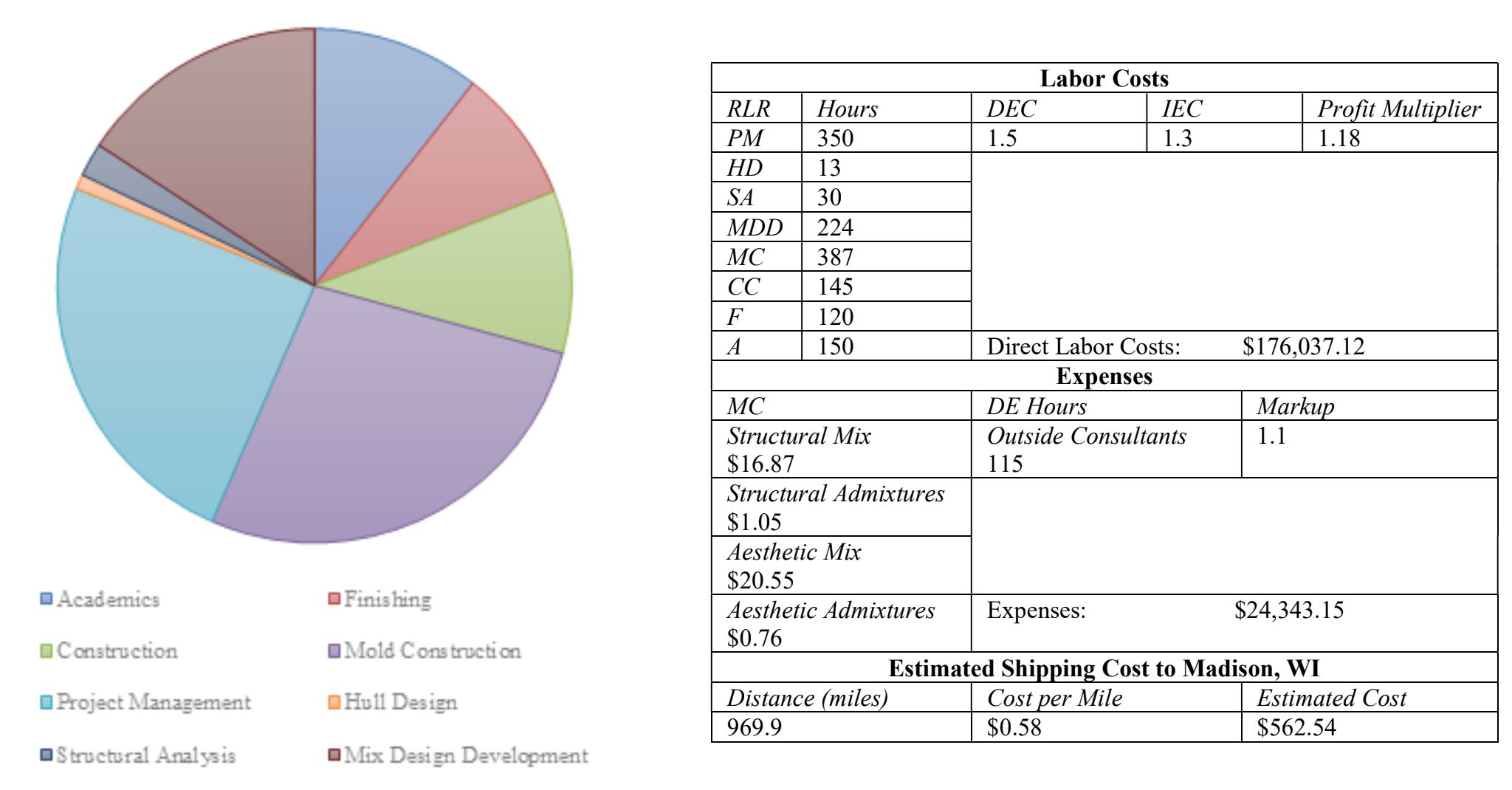
Schedule

The Final Product
Although we would have preferred to repair chips in our color ex-lays, sand the canoe, and finish the stands and displays, we are proud of what we did get done! Though it was stressful at times, we all had a great time working together and seeing our ideas progress to designs and ultimately a real canoe. The experiences we gained from this endeavor go well past just building a canoe, and will be beneficial for countless projects and adventures to come. Below are pictures of our final product.
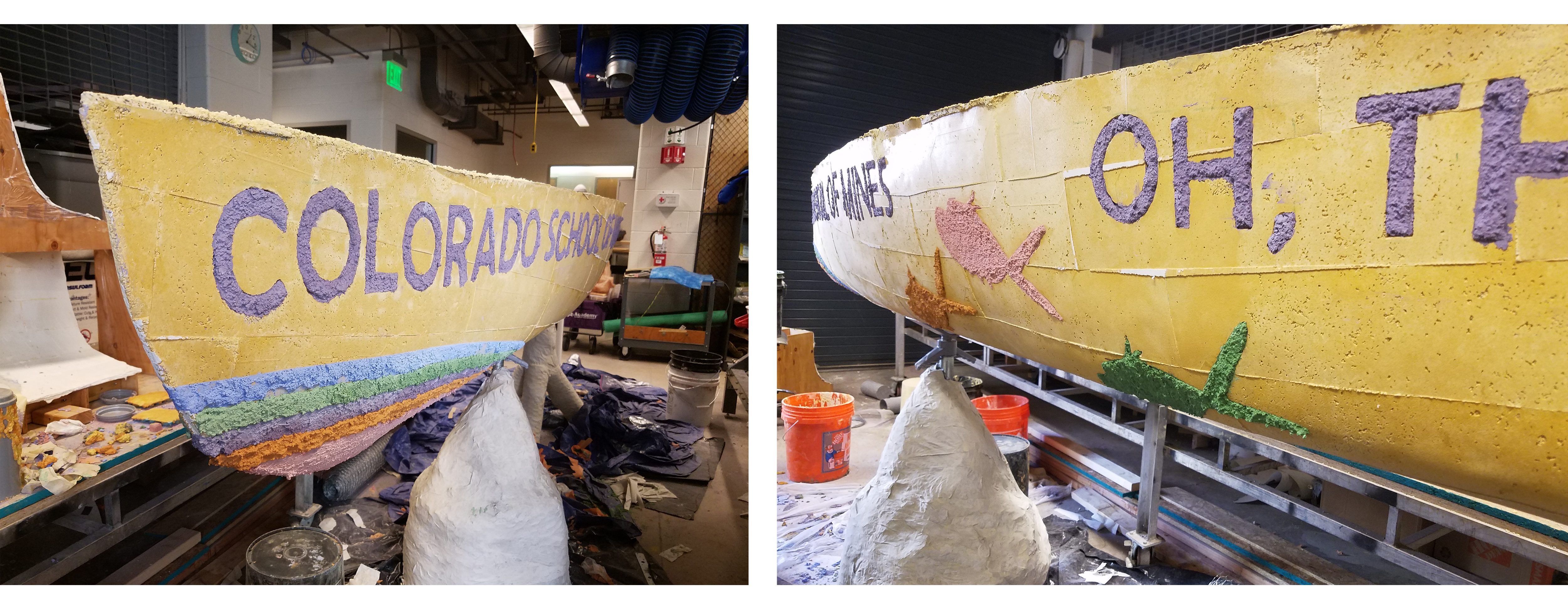
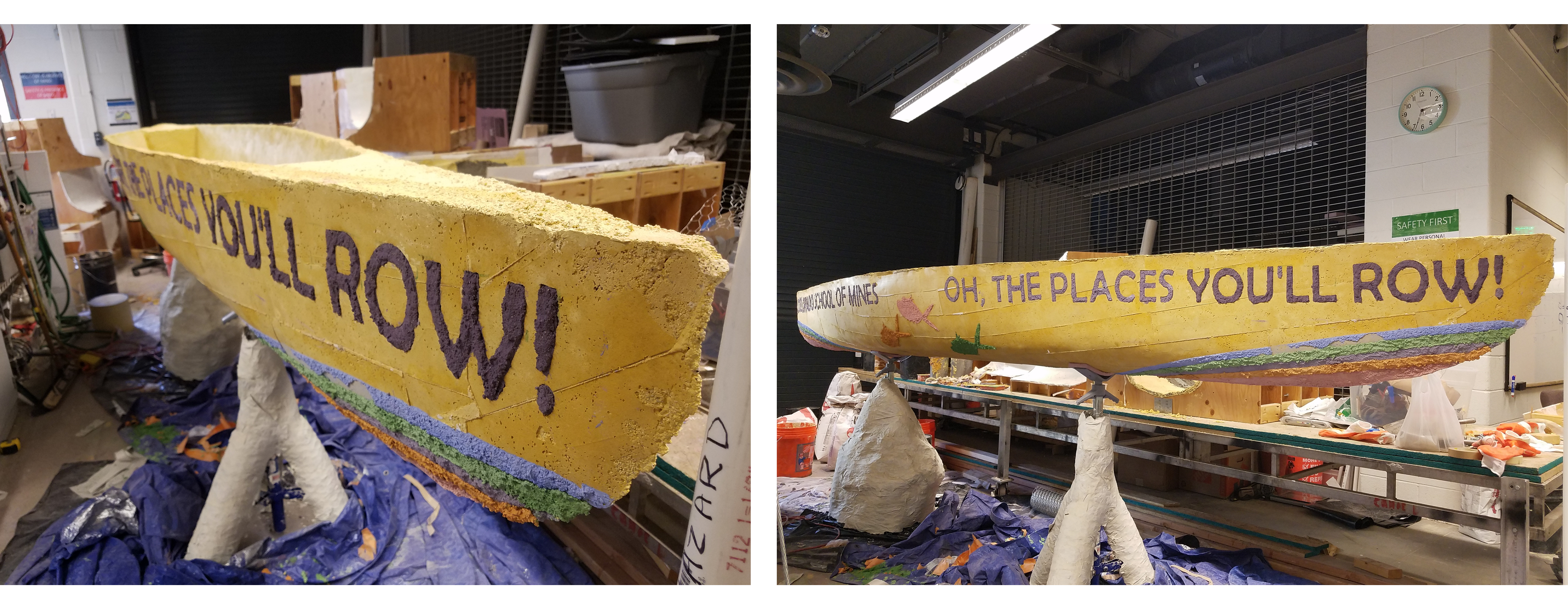
Next Steps
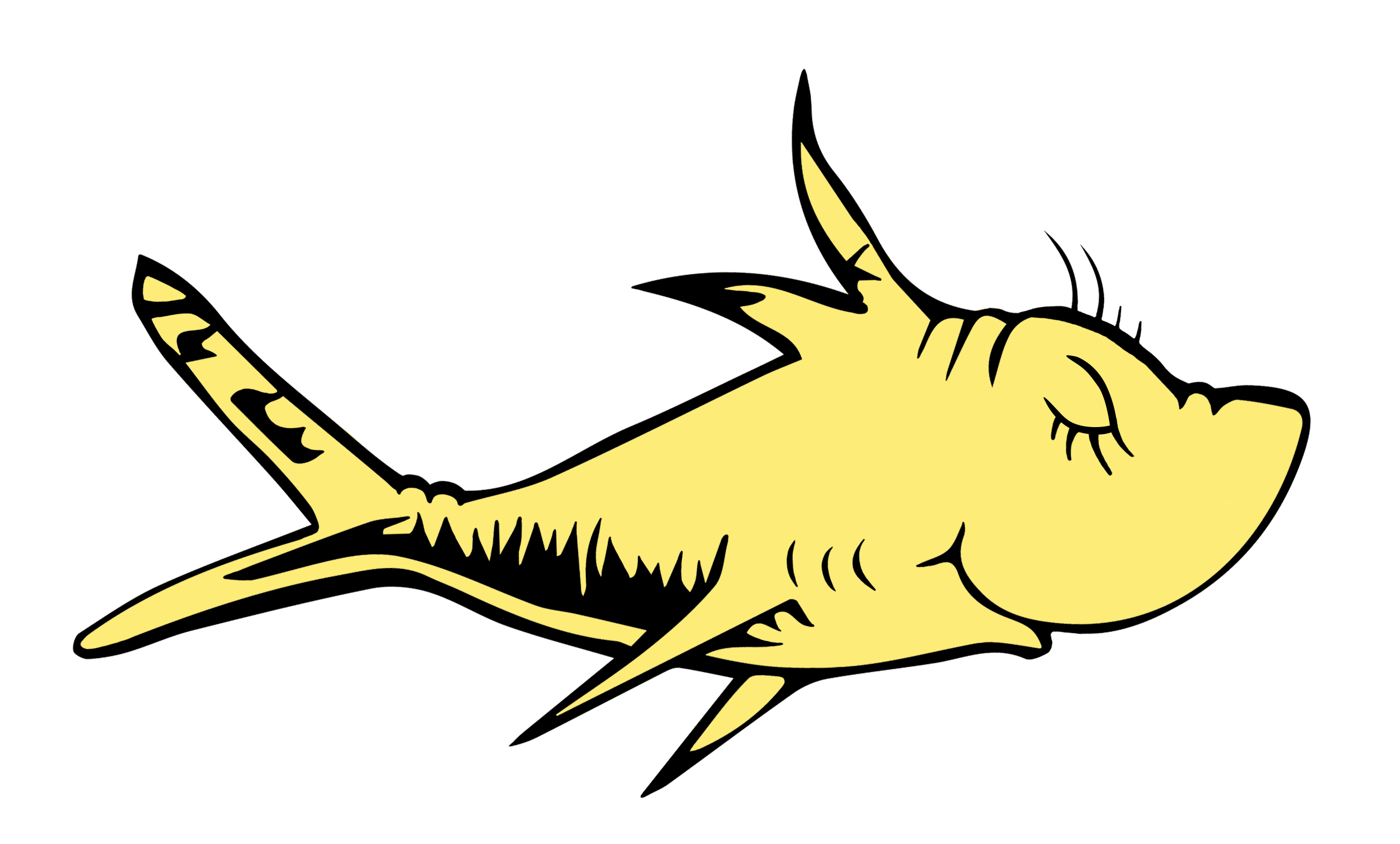 Because this project was cut short, a few objectives remain unfinished. If our team had the means to finish the project, the next tasks in line would be to sand the outside of the canoe for a smooth texture and to finish building and decorating the canoe stands. Sanding the canoe would decrease drag when racing, lower the weight of the canoe, and improve the overall aesthetic. We would also make a display for the competition, which would include a detailed cutaway of the form and canoe as well as a storybook-themed display of the materials used in the concrete mix.
Because this project was cut short, a few objectives remain unfinished. If our team had the means to finish the project, the next tasks in line would be to sand the outside of the canoe for a smooth texture and to finish building and decorating the canoe stands. Sanding the canoe would decrease drag when racing, lower the weight of the canoe, and improve the overall aesthetic. We would also make a display for the competition, which would include a detailed cutaway of the form and canoe as well as a storybook-themed display of the materials used in the concrete mix.
Moving forward and looking to next year’s team, we have some recommendations and aspects of the project that we would improve on. One suggestion we have is that teams continue with the wooden mold design for ease of building and pouring, but take better care in checking the thickness of each concrete layer. Reducing the width of the mold itself would also allow easier lean-ability into the canoe when placing concrete.
For the concrete, we would suggest aiming for a lower unit weight if it is decided to hand-place it. This would be beneficial unless a method is put in place to ensure that the intended thicknesses can be met on a large scale, such as on Pour Day. We would also recommend using a smaller aggregate in the aesthetic mix so that placement and sanding is easier.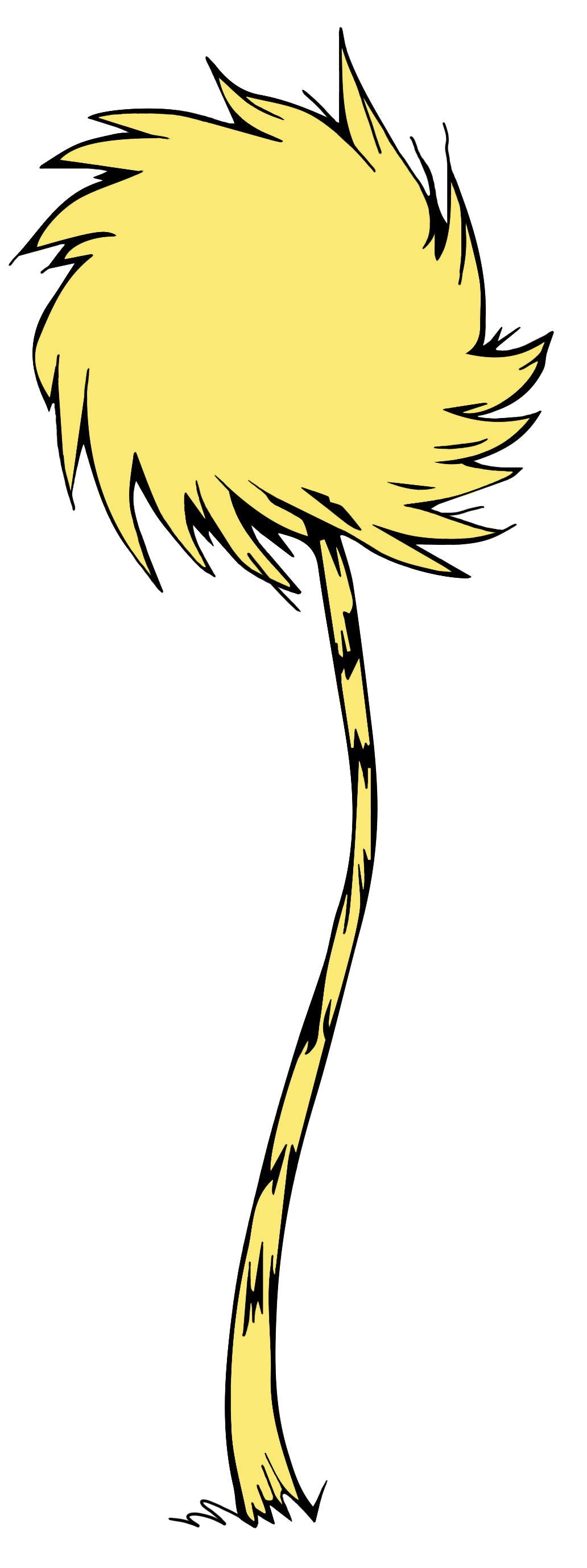
We believe that communication is key. Communicate with your PA often to ensure that purchasing can happen efficiently and in a timely manner, and always communicate with teammates about progress in the portion of the project you are managing. It can be a bit of work, but it will lead to a much more cohesive team. In regards to managing portions of the project, another recommendation we have is to assign roles based on the timeline of the project. For example, the aesthetic portion of the project will ramp up much later in the academic year, so people should be redistributed to other tasks at the beginning of the year. Though volunteering to help is effective, more fully-assigned roles could be more productive. [A general timeline that we experienced was mix design and hull design (early/mid), report and construction of form (mid), aesthetics/display elements/final touches and presentation (later).]
UPDATE!
After what seemed like an endless number of roadblocks, we launched the canoe on 10/17/20! It floated carrying 500+ lb, paddled fast and steered well, and passed the swamp test. Thank you to everyone who helped carry this beast and/or came to watch.
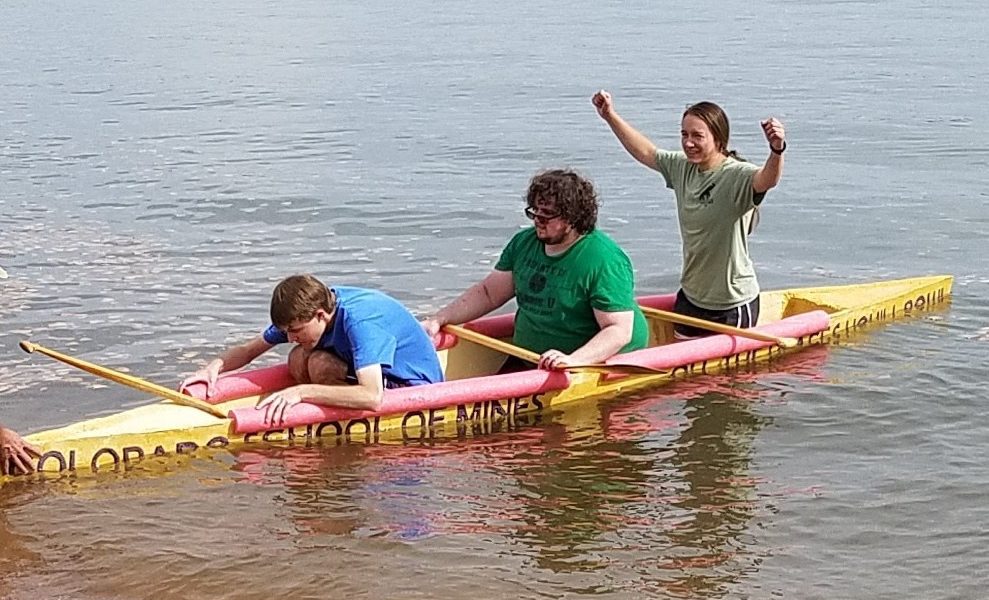
It holds 500+ lbs!
Meet the Team
Connor Beekman
![]() Hull Design & Structural Analysis
Hull Design & Structural Analysis
[Designed canoe hull using programs such as DELFTShip. Performed calculations on hydrostatics and load demands.]
“After graduation, I will be working as a transportation engineer. My work will include roadway design projects and traffic impact studies. In my free time, I enjoy hiking and photography.”
Lucy Davis
![]() Quality Control & Safety
Quality Control & Safety
[Managed team safety, enforced NCCC rules and regulations, and reviewed all calculations.]
“Hi my name is Lucy Davis, a graduating senior in civil engineering. After graduation, I plan on attending grad school in Portugal for structural analysis and historic construction and then pursuing a career in historic preservation or forensic engineering!”
Ryan Finnell
![]() Finance
Finance
[Managed budget and expenditures, led fundraising efforts. Served as communications liaison with the Bureau of Reclamation and GoldMine fundraising.]
Ryan Finnell is a senior in Civil Engineering and is continuing into graduate school to pursue a Masters in Hydrologic Science and Engineering. He has previously interned at Vulcan Materials, where he helped operate one of the largest aggregate mines in California.
Matthew Kouba
![]() Deliverables Manager
Deliverables Manager
[Compiled design documents for NCCC. Edited, reviewed and submitted all deliverables. Directed design and assembly of presentation.]
“It was a joy being able to work with this concrete canoe team during my senior year and it was cool seeing the canoe come together from an idea to an actual 500 pound product. This is just one of the memorable experiences I will hold on to from my time at Mines as a civil engineering student. I look forward to seeing the successes our future team achieves as I will be returning to Mines next year for a Masters in Structural Engineering.”
Antoine Broeckx
![]() Construction Manager
Construction Manager
[Ensured an organized and clean workspace and created an inventory of available materials. Managed mold, canoe, and carrier construction.]
Camille Faatz
![]() Mix Design Lead
Mix Design Lead
[Consulted with industry professionals to develop concrete mix designs through testing. Served as communications liaison with Martin Marietta. Led volunteer students in sieving operations.]
“Through my experiences during concrete canoe, I’ve gotten really interested in the material science of concrete, including mix design and testing/data analysis. I am looking forward to an internship at Martin Marietta to learn about and gain more experience with concrete in the lab and field!”
Brittany French
![]() Aesthetics Manager
Aesthetics Manager
[Ensured a comprehensive and consistent design for the finished canoe. Managed design and fabrication of inlays/outlays for canoe.]
Lydia Prather
![]() Project Manager
Project Manager
[Managed project schedule, assisted design leads and managed assistant members.]
“My name is Lydia and I was the project manager for this year’s concrete canoe team. After graduation I will be attending the University of Colorado Denver in the Fall for a masters in architecture.”
Gallery – The whole process!
1.24.20
Great time for the trailer to break (kidding) — canoe & trailer were stuck outside in snow for weeks
Contact the Team
Thank You:
Mikheil Abuladze, Derek Ackley, Alex Berry, Thomas Brightwell, Faylyn Bruecken, Delaney Brown, Harrison Bruno, Abby Bullard, Celeste Carmignani, Mary Collins, Abbegayle Culig, Nathan Davis, Dillon Davisson, Inge Delius Cordova, Megan Dickson, Teague Dilbeck, Zachary Drennan, Mackenzie Duck, Danielle Duis, Reese Dyer, Anker Eisenman, Brody Evans, Madeline Finley, Kate Fiore, Kevin Fitch, Ian Fromm, Todd Genovese, Cody Goebel, Riley Goetz, David Grimm, Denver Hargrove, Cooper Henry, Joseph Herr, Jeffrey Holley, Jarod Horton, Carson Introligator, April Jergensen, Brayden Johnk, Margo Lawless, Christian Lemishko, Michael Lim, Catherine Lucero, Tucker Mattson, Ryan McKee, Glen Miller, Gregory Miller, Anna Mounts, Megan Neil, Brayden Nichols, Nigel Noah, Stephen O’Brien, Samuel O’Keeffe, Mikayla Oligney, Antonios Paganis, Carly Paige, Natashia Power, Clare Quaid, Elias Ramirez Melendez, Caleb Roth, Cole Sexton, Quincy Smith, Brenden Sullivan, Grant Te Velde, Trevor Valder, Samantha Van Sickle, Jeffrey Wilson, Michaela Wright, Jessica DiCaprio, Leonel Ornelas, Neo Huang, Jacob Tunnah, Regan Van Overbeke, Isabella Boecker, Kyle Webb, Lauryn Brewer, Kevin San, Paldo Lopez, Slater Sorensen, Kate Jones, Ida Gorner, Charlie Petersen, Louise Anhel, Kori Davis, Matthew Baum, Isabel Whitehead, and Terrance Zhou; AND everyone who donated to our GoldMine page!
